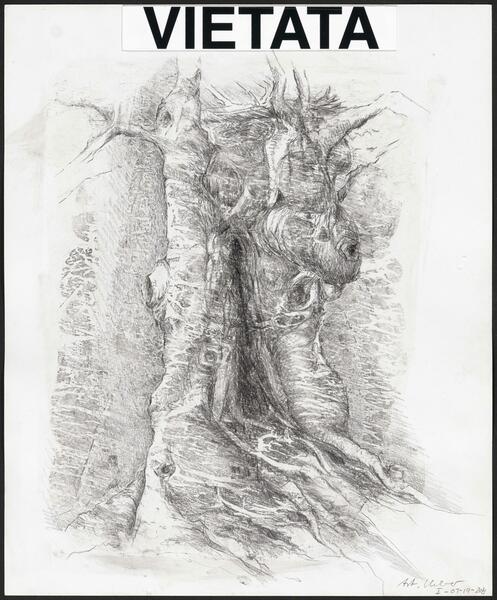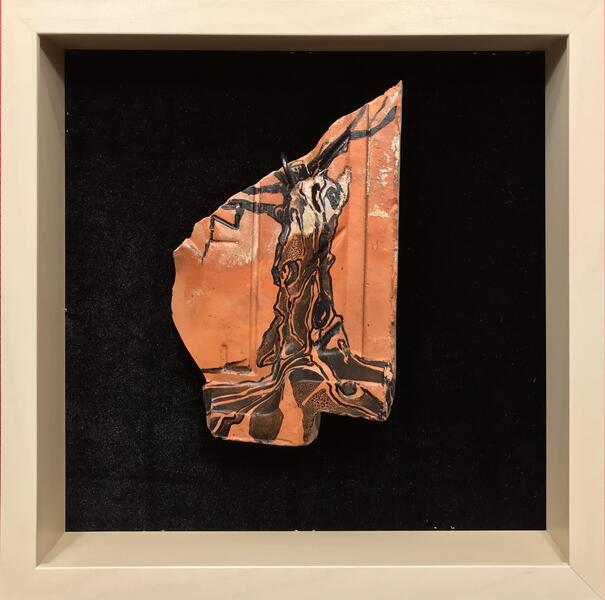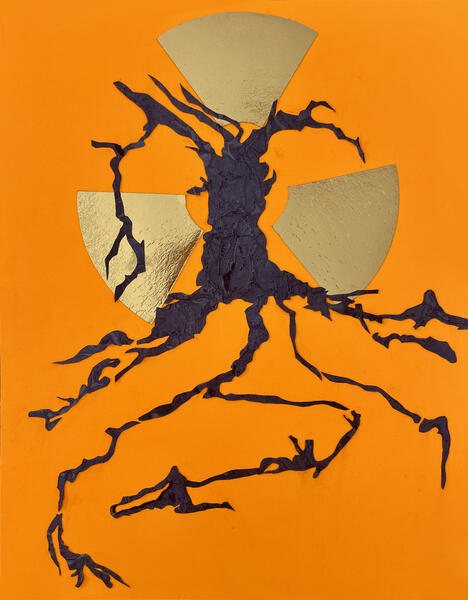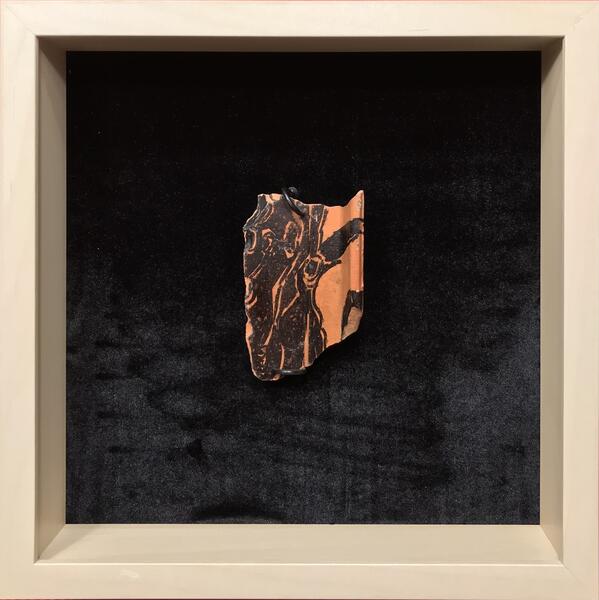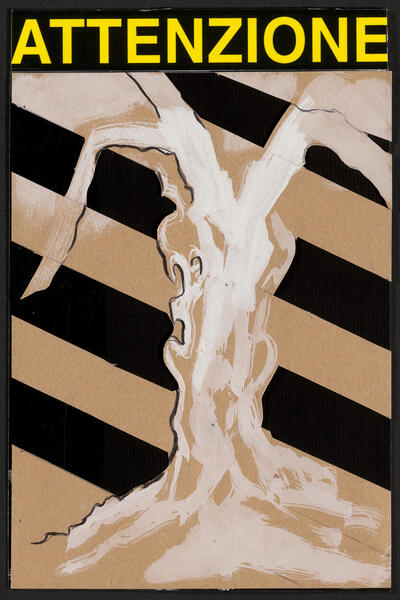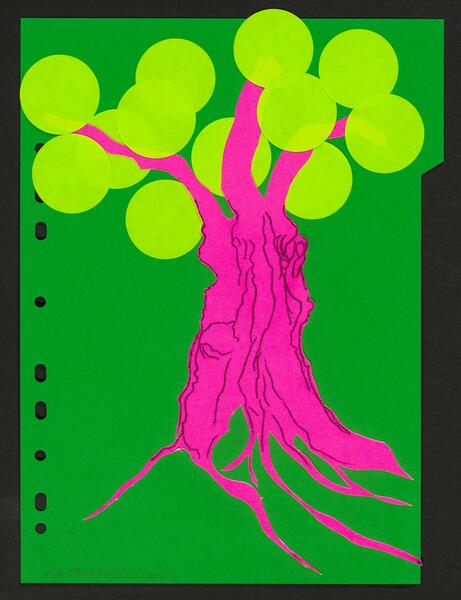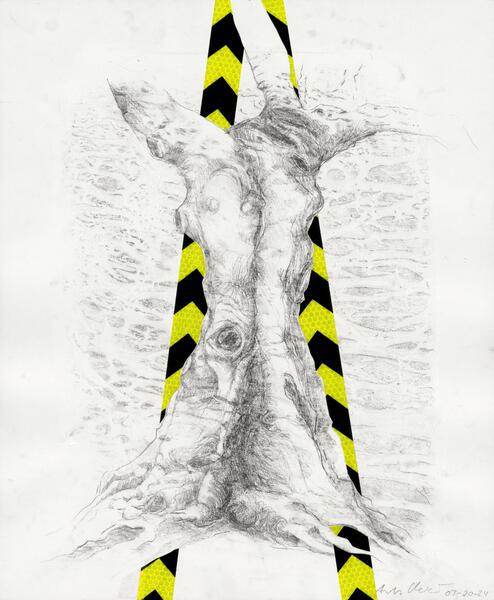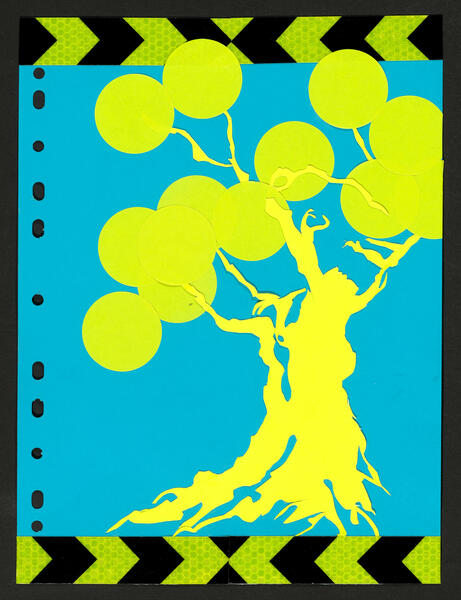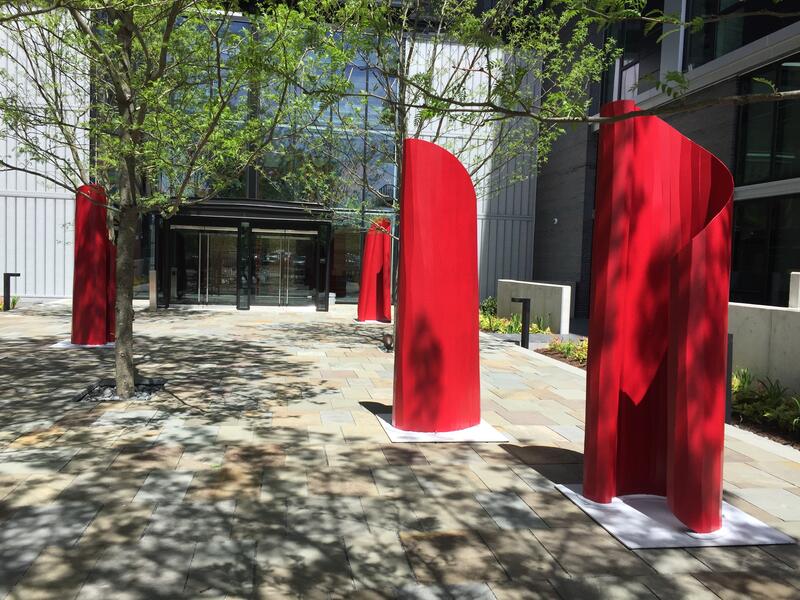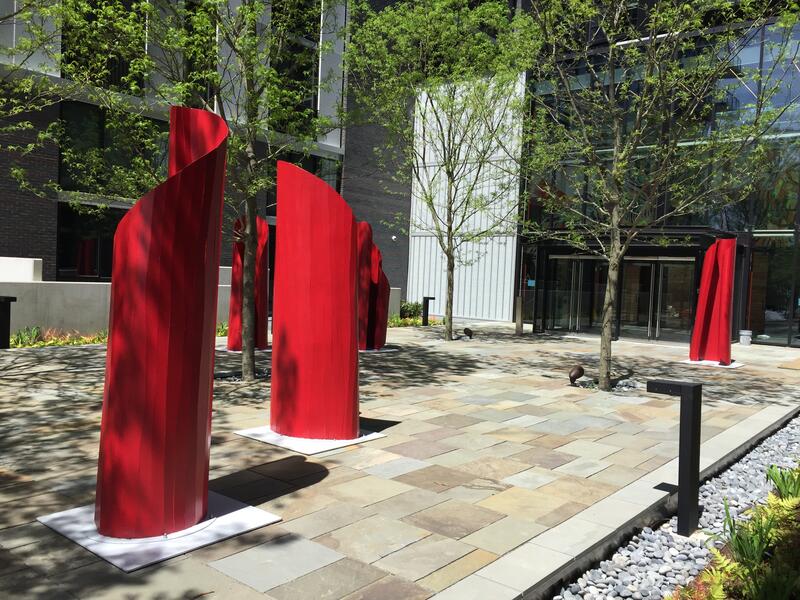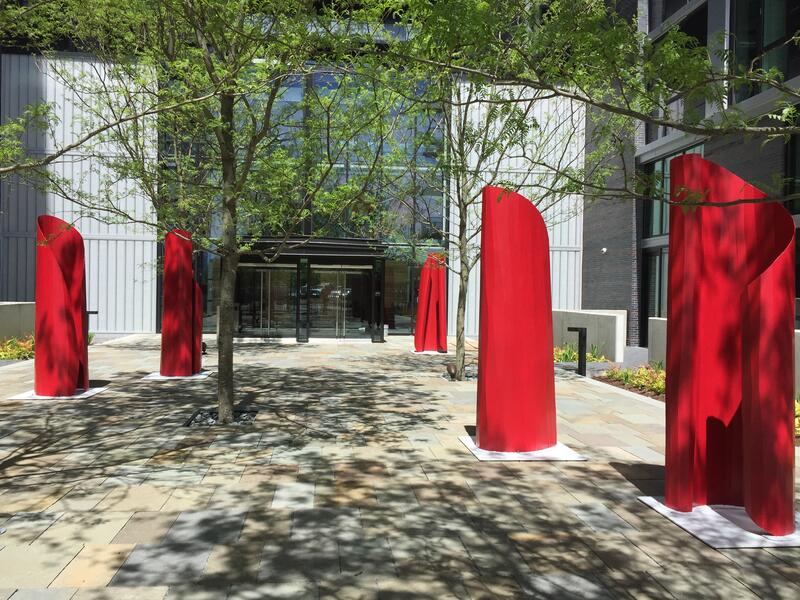Work samples
-
Danger Zones Performance, 2023
My work reveals the transient nature of our environment, shaped by human influence. Drawing inspiration from my background in experimental geography and polit-myth, my creations serve as moving reflections of the Anthropocene era, capturing the essence of movement and transfiguration within our shared environments. Collaborating with dancer and artist Cynthia Word of Word Dance Theater, I further dive into the intricate relationship between the body, the land, and nature. Through experimental performative explorations, bodies disappear into the cavernous hybrid topographies that embodies memory itself, shaping the spirit of the Earth. In these metamorphic processes, there exists no distinction between object and subject, creator, and creation. The performance, documented through images and video, becomes a directed happening—a visceral exploration of the human presence within the evolving landforms.
-
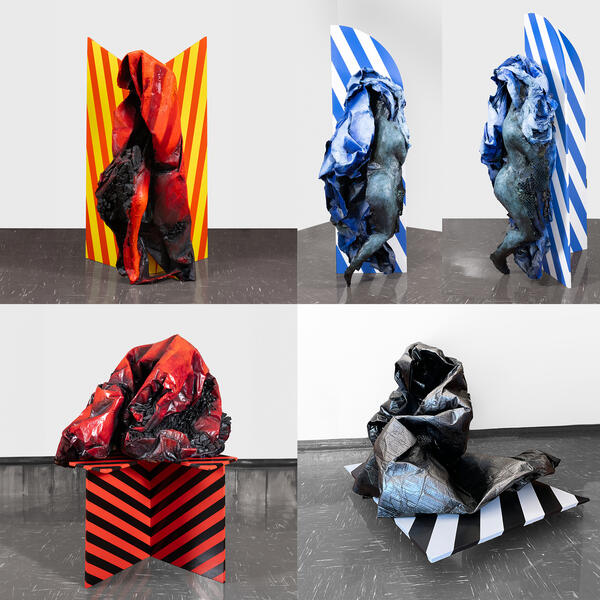 Danger Zones Sculptures, 2023-2024
Danger Zones Sculptures, 2023-2024Corrugated cardboard, acrylic paint, mixed media, and wooden boards, Average of 100" x 80" x 45". My work contradicts the traditional boundaries of the art world partitions by seamlessly blending sculpture and painting, utilizing corrugated cardboard as my primary medium. This choice blurs the lines between creation and created, inviting viewers to reconsider their preconceptions of art and the milieu. The transmutation of cardboard is a labor-intensive process, involving soaking, sculpting, and layering with various mixed-media items. These materials, ranging from textures reminiscent of deep time materials like coal and marble to manmade substances such as tar and asphalt, imbue topographies with a tactile richness and complexity.
Danger Zones pulsates with the rhythm of human activities, capturing the core of transformation, fragility, and resilience. Unlike traditional environmental art, which often focuses on specific incidents or events, my work encompasses the broader implications of the Anthropocene. It transcends the limitations of land art by defining landscapes not by the land itself, but by the impressions and memories left by the human body.
-
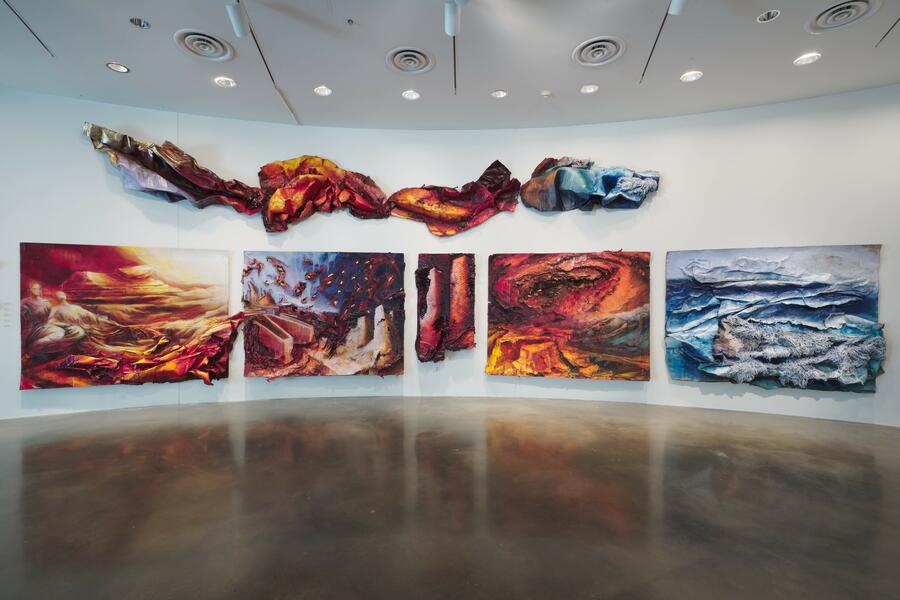 Gaia Cycle Panorama, 2019 - 2020
Gaia Cycle Panorama, 2019 - 2020Acrylic, mixed media on corrugated cardboard, Average size 90" x 100". The Gaia Rise cycle is a large-scale wall installation of distinct mythological themes combined as a tapestry of either devastated, neglected or exploited landscapes animated by Gaia and her close/far relatives, revealing a human condition that is at stake as well as our planet Earth. I understand Gaia as a local issue on a global level. Through my explorations of experimental geography, I travel to various places to experience and multiply the complexity and concept of Gaia Rise. Each place of my excursions informs my current concept, exploring Gaia’s local complexities, revealing entanglements between human actions and environmental fragility.These site-specific insights inform my artistic practice, incorporating narratives that examine humanity’s engagement with Earth’s surface. Gaia’s story is a call to recognize our role in her precarious balance, demanding care and awareness in every action we take. Gaia is not a nurturing “Mother Earth” but a fragile, precarious force scarred by human recklessness. Drawing on Hesiod’s theology, I see Gaia as both prolific and violently cataclysmic—indifferent to us as we are to her.
-
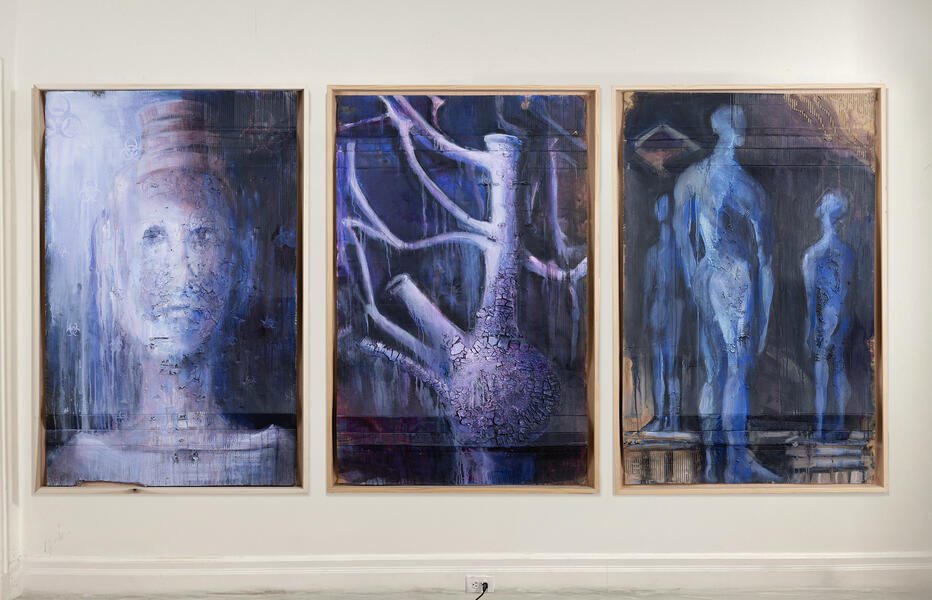 Beneath the Present
Beneath the PresentBeneath the Present (here pictured three paintings out of many, Acrylic and mixed media on corrugated cardboard (each 60" x 44") left to right: "Kassandra," "Alchemic Vessel," "Underworld") peers into my Greek heritage, excavating concepts of ancient myths and utilizing it as a lens to view our current climate emergency. Using cardboard, brown packing paper, tiles, deep time materials, and aggregates such as charcoal, marble dust, tar, and plaster my ongoing series deriving from the concept of Ancient Greek Lekythos (an urn, where the ashes of the deceased is stored and buried). The imagery used in this series of large-scale framed paintings done on cardboard, references the ancient Greek funerary practice of the same name – similar to an urn. This use of death imagery – combined with the selected mythologies – speaks to our current crisis not only for humans but every Earthbounder. Here, I merge our current material culture with histories and narratives of the Anthropocene that sediment into layers of geologies of exploitation from manmade tectonic activities, geographies of place and time. Aggregates, matter, and found materials have been dissolved and incorporated into tattered textures the wall works re-emerge as fragmented memory that coincides with experiences of trauma and pain of a dying world for all Earthbounders.
About Artemis
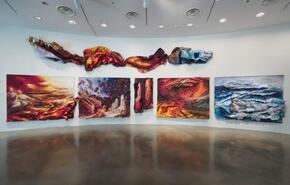
Artemis Herber shows where we currently stand. Humans have made the world fragile, and the collapse shows around each corner.
The German-Greek artist shows how deep time is transformed into fleeting moments through human activities. For this she primarily uses matter from geological time or materials that come out of the mining and… more
D'Olivo Millenario
Centered on the 1000-year-old Olivastra tree I have encountered during my La Baldi residency, this series -“L’Olivo Millenario”- positions these trees with their gnarled trunks and resilient growth to embody the tensions and harmonies between human cultivation and natural processes. Based on my research of the Olivastra olive tree during my residency in Italy, I developed an iconography of the olive tree as a portrayal of life and existence. These trees are living witnesses to centuries of environmental and cultural change, from the agricultural innovations of medieval monks to the industrial transformations of the Anthropocene. This new project crosses not only boundaries across disciplines but integrates entanglements between the natural and the human. Thereby, I formed kinship with the tree and the cultivated land of the region to reach deeper into the meanings found in their growth, transformation, and resilience of this species that have survived wars, societal change, and the risk of having them be abandoned.
DANGER ZONES - Memory Trace and Place
Within my artistic exploration, I delve into the transient nature of our environment, molded by human influence. Violence always leaves a trace, and conflict embeds memories that serve as references for future resolutions. The series Danger Zones envisions our future selves within the histories of human activities and their impact on our world.
Through combining sculpture and painting, I challenge conventional landscape depictions, moving away from the idyllic portrayal of nature. Instead, I confront the harsh reality of an environment besieged by degradation and imbalances. Employing innovative techniques with corrugated cardboard, I blur the boundaries between creator and creation, capturing movement and transformation. My process creates landscapes adorned with intricate textures, merging deep-time materials with human-made substances, exploring unresolved conflicts against nature and each other.
Danger Zones incorporates performative bodywork, animating mythical topics representing our volatile Earth. Collaborating with dancers, I wrap wet cardboard around them, creating a trace of their movements once dried. Merging dance and visual art births a hybrid exploration of humanity's delicate interplay with nature and the consequences of intervention.
Within the work, cast body parts dissolve into geological folds, symbolizing fragmented memories and mortality. Amid discussions of extinction, I emphasize how memories fade with our existence. Impending destruction is portrayed through disintegrating forms juxtaposed with sharp geometric spaces, highlighting human intervention's impact. Bodies and environment merge into a singular piece, while danger zones persist as impending threats.
Danger Zones examines time's complexities, weaving past, present, and future into an artistic exploration. It speaks a metaphorical language bridging art, politics, and the environment, inviting us to navigate life's changing currents.
Through experimental gestures and painterly actions, I navigate Danger Zones as a delicate sphere we inhabit. This approach yields multi-leveled expressions, emphasizing vulnerability and the urgency of living in endangered zones.
-
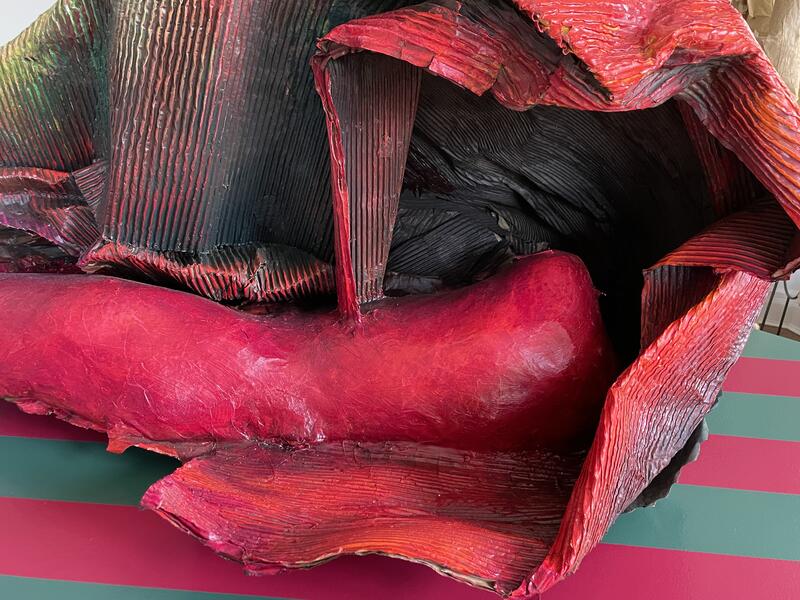 Siebenschläfer - detail
Siebenschläfer - detailSiebenschläfer - detail
Acrylic and mixed media on corrugated cardboard, 24x40” (d) / table 71x41x31”, 2023
Siebenschläfer reflects on the chthonic concept of hiding, sheltering, and waiting. The half body cast is integrated in a cave like landscape formation that allows both views the upper and under world. The figure is painted in Magenta red and set up on a table in green and Magenta warning stripes, a color combination referring to radiation hazards as well safety and first aid.
The sculptural installation is inspired by the story of the Seven Sleepers of Ephesus waiting 300 hundred years in darkness, within rock until it is safe to emerge. Those stories not only reference to histories of persecution, displacement, and escape.
Those stories keep larger narratives of present and future concerns; about nuclear fear and encounter uncanny confrontation of realities. It deals with perspectives of forgetting as planned for the nuclear waste site of Olkiluotu in Finnland, or with future warnings with respect to the Waste Isolation Pilot Plant (WIPP) 26 miles southeast of Carlsbad, New Mexico. WIPP permanently isolates defense-generated transuranic (TRU) waste 2,150 feet underground in an ancient salt formation.
-
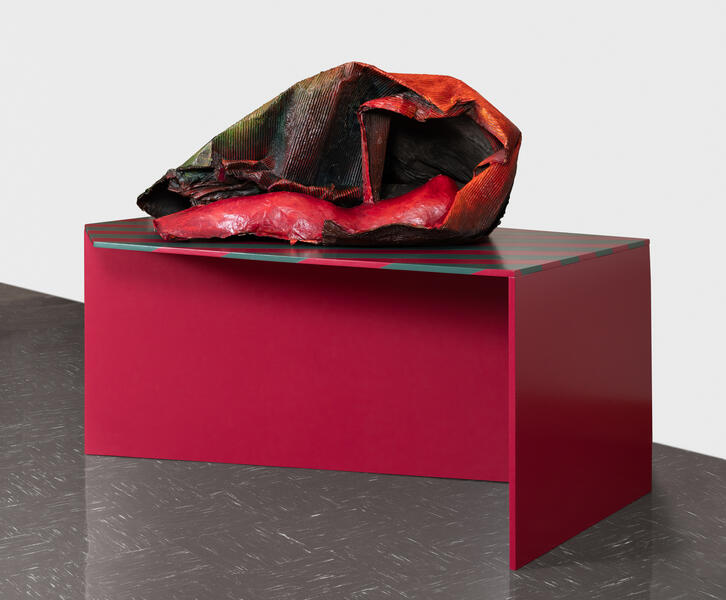 Siebenschläfer
SiebenschläferSiebenschläfer
Acrylic and mixed media on corrugated cardboard, 24x40” / table 71x41x31”, 2023
Siebenschläfer reflects on the chthonic concept of hiding, sheltering, and waiting. The half body cast is integrated in a cave like landscape formation that allows both views the upper and under world. The figure is painted in Magenta red and set up on a table in green and Magenta warning stripes, a color combination referring to radiation hazards as well safety and first aid.
The sculptural installation is inspired by the story of the Seven Sleepers of Ephesus waiting 300 hundred years in darkness, within rock until it is safe to emerge. Those stories not only reference to histories of persecution, displacement, and escape.
Those stories keep larger narratives of present and future concerns; about nuclear fear and encounter uncanny confrontation of realities. It deals with perspectives of forgetting as planned for the nuclear waste site of Olkiluotu in Finnland, or with future warnings with respect to the Waste Isolation Pilot Plant (WIPP) 26 miles southeast of Carlsbad, New Mexico. WIPP permanently isolates defense-generated transuranic (TRU) waste 2,150 feet underground in an ancient salt formation.
-
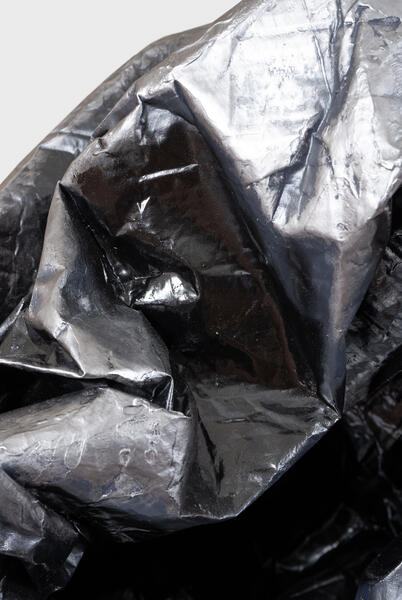 Mnemosyne - detail
Mnemosyne - detailMnemosyne
Acrylic, graphite powder, and mixed media on corrugated cardboard, 34x44’ (d)/ wood bord b/w 48x 48”, 2023
Over time and histories bodies transformed into mythical figures embedded in mythical landscape of “Mnemosyne”, the Titan of memory and mother of the Nine Muses, that give art a voice. The hollow sculpture is kept minimal and discreet, just painted in black and dusted with graphite pigments set on a hazardous zone area marked in black and white. The simplicity of the setting referrers to the infinity of universal knowledge in the hollow space while memory (Mnemosyne) seems at risk with ephemeral matter of powder coated shiny surfaces in a hazardous environment.
My new sculptures animated through performative bodywork recall those myths as updated versions of our current volatile and precarious conditions on Earth.
-
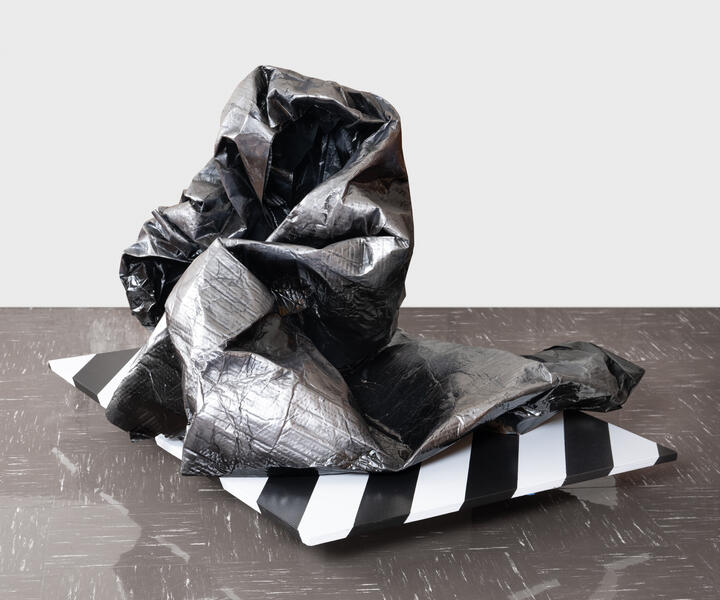 Mnemosyne
MnemosyneMnemosyne
Acrylic, graphite powder, and mixed media on corrugated cardboard, 34x44’ (d)/ wood bord b/w 48x 48”, 2023
Over time and histories bodies transformed into mythical figures embedded in mythical landscape of “Mnemosyne”, the Titan of memory and mother of the Nine Muses, that give art a voice. The hollow sculpture is kept minimal and discreet, just painted in black and dusted with graphite pigments set on a hazardous zone area marked in black and white. The simplicity of the setting referrers to the infinity of universal knowledge in the hollow space while memory (Mnemosyne) seems at risk with ephemeral matter of powder coated shiny surfaces in a hazardous environment.
My new sculptures animated through performative bodywork recall those myths as updated versions of our current volatile and precarious conditions on Earth.
-
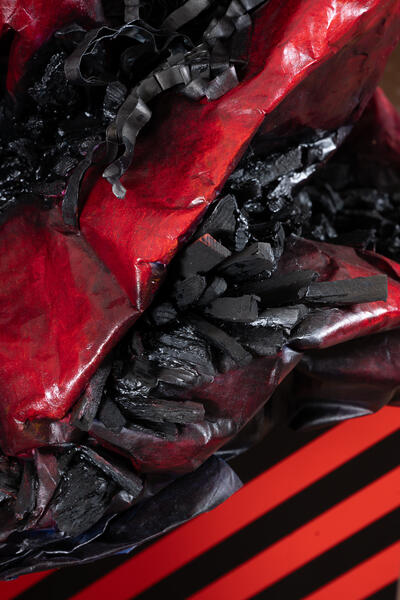 Phlegthon - detail
Phlegthon - detailPhlegethon - detail
Acrylic and mixed media on corrugated cardboard, 32x37 (d) / table 26,5x44” (d), 2023
Literally a "river of fire" (Aen. 6.550-1). In Greek mythology, Phlegethon was one of the five rivers in the infernal regions of the underworld, along with the rivers Styx, Lethe, Cocytus, and Acheron.
Plato describes it as "a stream of fire, which coils round the earth and flows into the depths of Tartarus". The river is so hot that it's cold to the touch. It is said to appear like a torrent of burning gasoline that lights up everything red.
I seek to identify common undercurrents in the geo-terrestrial and political developments. Color, shape, and charcoal chips composition refer to the fiery appearance of the sculpture carried out by the human body. The sculpture is positioned on a cross shaped table with diagonally oriented black and red caution stripes usually referring to crime scenes. As caution tapes, the markers are used to mark off areas where a crime or accident has occurred and to warn people to stay away.
This way the human-made landscape is elevated on a marked zone as a significant endangered area. The cloudlike sculptural formation veil and hide, spreads fear and danger that man must have from himself- an aesthetic visualization becomes self-encountering.
-
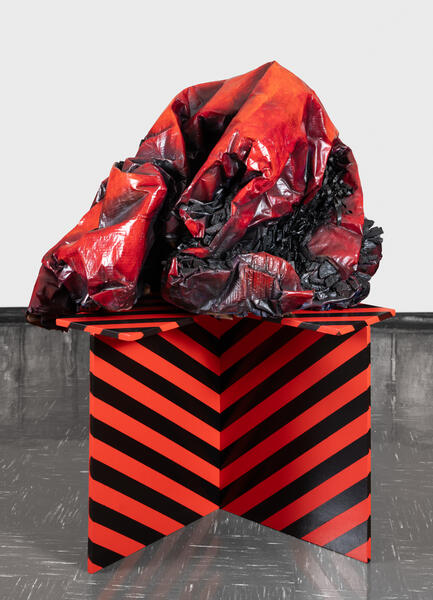 Phlegeton
PhlegetonPhlegethon
Acrylic and mixed media on corrugated cardboard, 32x37 (d) / table 26,5x44” (d), 2023
Literally a "river of fire" (Aen. 6.550-1) In Greek mythology, Phlegethon was one of the five rivers in the infernal regions of the underworld, along with the rivers Styx, Lethe, Cocytus, and Acheron.
Plato describes it as "a stream of fire, which coils round the earth and flows into the depths of Tartarus". The river is so hot that it's cold to the touch. It is said to appear like a torrent of burning gasoline that lights up everything red.
I seek to identify common undercurrents in the geo-terrestrial and political developments. Color, shape, and charcoal chips composition refer to the fiery appearance of the sculpture carried out by the human body. The sculpture is positioned on a cross shaped table with diagonally oriented black and red caution stripes usually referring to crime scenes. As caution tapes, the markers are used to mark off areas where a crime or accident has occurred and to warn people to stay away.
This way the human-made landscape is elevated on a marked zone as a significant endangered area. The cloud-like sculptural formation veil and hide, spreads fear and danger that man must have from himself - an aesthetic visualization becomes self-encountering.
-
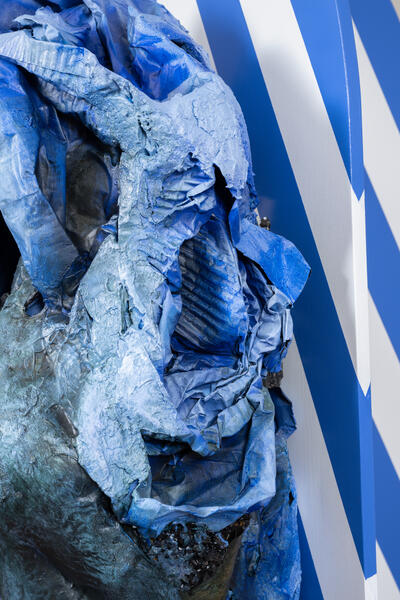 Starless Rivers - detail
Starless Rivers - detailStarless Rivers, Acrylic and mixed-media on corrugated cardboard, wooden boards, 84 x 44 x 30 inches, 2023
Inspired by Robert Macfarlane deep time journey of “Underland” (2019) ancient starless rivers flow from the upper world into the under land. “The reason that classical literature runs with rivers dipping into darkness is geological: so much of the landscape in which that literature was lived and written is karstic in nature.” However, it also borrows histories that flow from conflict zones of Roman’s antiquity Mithraism towards the economic underworld, the basement in London’s Bloomberg building, crossing European war zones into the 20th century.
“Rivers disappear and so do stories, only to rise again in unexpected ways.”
Robert Macfarlane
-
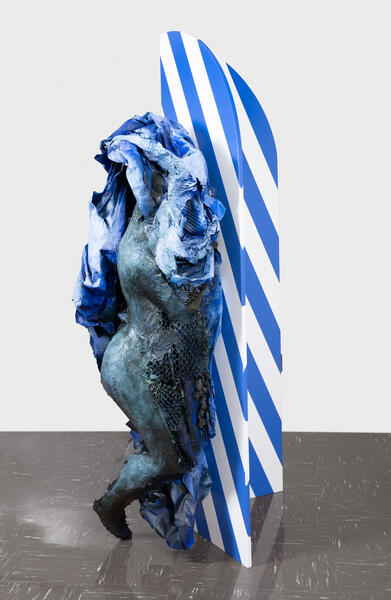 Starless Rivers
Starless RiversStarless Rivers, Acrylic and mixed-media on corrugated cardboard, wooden boards, 84 x 44 x 30 inches, 2023
Inspired by Robert Macfarlane deep time journey of “Underland” (2019) ancient starless rivers flow from the upper world into the under land. “The reason that classical literature runs with rivers dipping into darkness is geological: so much of the landscape in which that literature was lived and written is karstic in nature.” However, it also borrows histories that flow from conflict zones of Roman’s antiquity Mithraism towards the economic underworld, the basement in London’s Bloomberg building, crossing European war zones into the 20th century.
“Rivers disappear and so do stories, only to rise again in unexpected ways.”
Robert Macfarlane
-
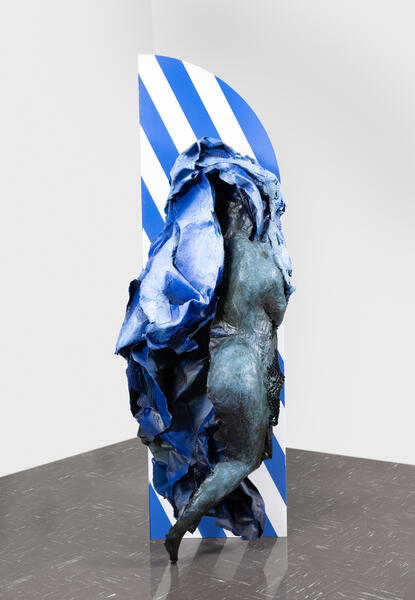 Starless Rivers
Starless RiversStarless Rivers, Acrylic and mixed-media on corrugated cardboard, wooden boards, 84 x 44 x 30 inches, 2023
Inspired by Robert Macfarlane deep time journey of “Underland” (2019) ancient starless rivers flow from the upper world into the under land. “The reason that classical literature runs with rivers dipping into darkness is geological: so much of the landscape in which that literature was lived and written is karstic in nature.” However, it also borrows histories that flow from conflict zones of Roman’s antiquity Mithraism towards the economic underworld, the basement in London’s Bloomberg building, crossing European war zones into the 20th century.
“Rivers disappear and so do stories, only to rise again in unexpected ways.”
Robert Macfarlane
-
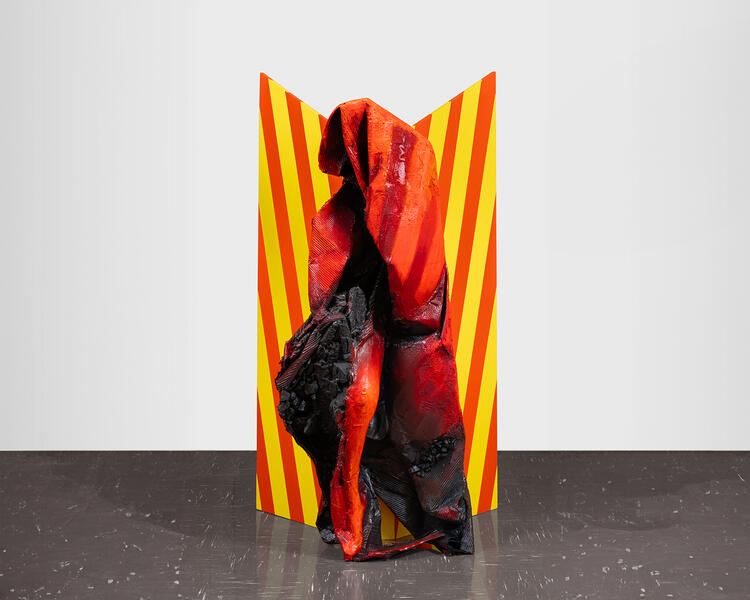 Persephone
PersephoneIn the development of new sculptures I collaborate with Cynthia Word of Word Dance Theater through experimental performative explorations with corrugated cardboard. The performance activates the sculptural form in the most subjective way by shaping an object from the inside out. There’s no difference between object and subject, or object and maker.
The body and movements give the sculpture transformative and final shapes. Using corrugated cardboard serves a sturdy cover that once left behind leaves an empty shell of memory from previous actions.
Scattered scraps falling apart and disintegration of the material in consequence of the performance reflect on the temporalities relating to the disappearance of our surroundings. Working with landscape images, I try to eliminate the old and creating new ones. The cliché of passed down landscape scenery and images include an overcome concept of nature that carries the notion of the beautiful view and nature as something elevated or to protect. At the same time, we observe overwhelming evidence of the destruction of nature, a dying world of multi-species, and atmospheric imbalances effecting our biosphere.
The collaboration between dance and the visual art promotes hybrid prefigurations to understand precarious condition between human and nature, between intervention and their consequences. It is important now and for the future to understand landscapes in a new way, to see them differently, not just from what we know. I reflect on man as a producer and destroyer of land as a contemporary landscape, as something that speaks for our current time and the future. What is left are traces of memory, fragmented, and fragile in their existence.
Beneath the Present
Beneath the Present - Lekythos Series 2020 - 2024
-
Hazardous II, 2021
Hazardous II, 2021
Found broken tiles, caution barrier tape, acrylic on corrugated cardboard in wooden shadowbox, ca. 64x40"
-
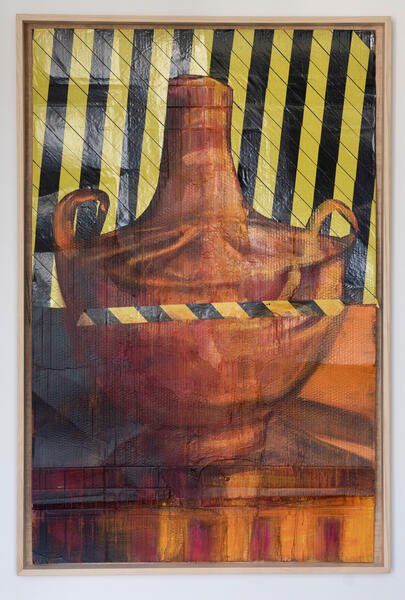 Hazardous I, 2021
Hazardous I, 2021Hazardous I, 2021
Physical hazard caution barrier tape, acrylic on corrugated cardboard in wooden shadowbox, ca. 64x40"
-
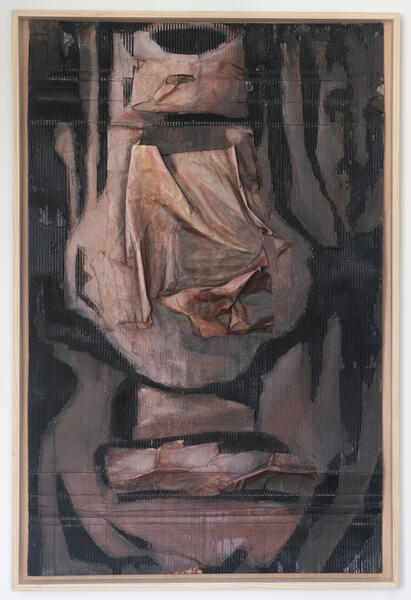 I Remember your Touch, 2021
I Remember your Touch, 2021I Remember your Touch, 2021
Found cardboard box, unfolded and rearranged, acrylic on corrugated cardboard in wooden shadowbox, ca. 64x40"
-
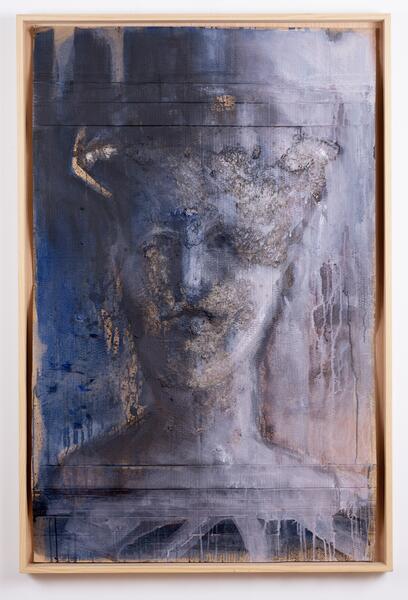 The Apparition of Euridice, 2022
The Apparition of Euridice, 2022The Apparition of Euridice, 2022
Mixed media, pulp from scratch, inkt, acrylic on corrugated cardboard in wooden shadowbox, ca. 64x40"
-
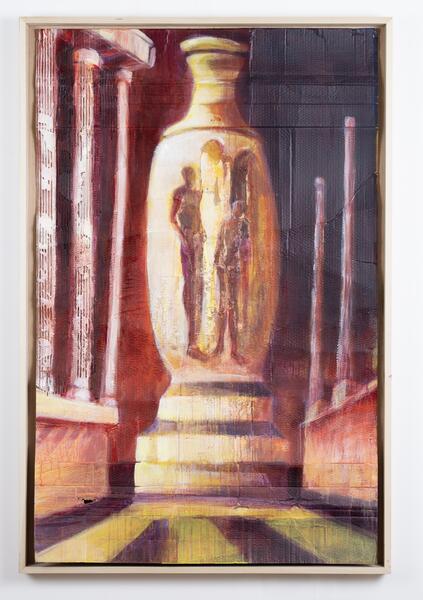 The Farewell, 2023
The Farewell, 2023The Farewell, 2023
Mixed media, acrylic on corrugated cardboard in wooden shadowbox, ca. 64x40"
-
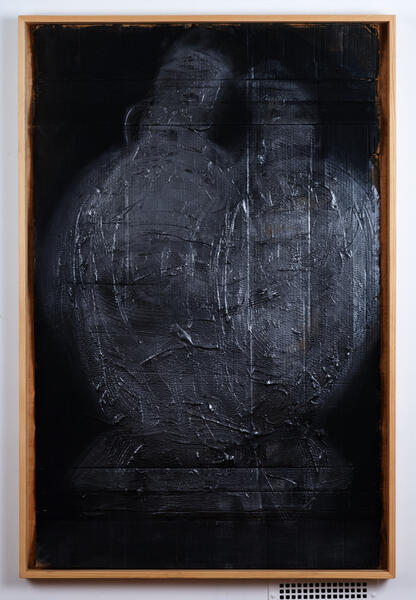 Kinship
KinshipKinship, 2023
Acrylic, charcoal, ink, graphite powder on corrugated cardboard in wooden shadowboxes, ca. 64x40”
-
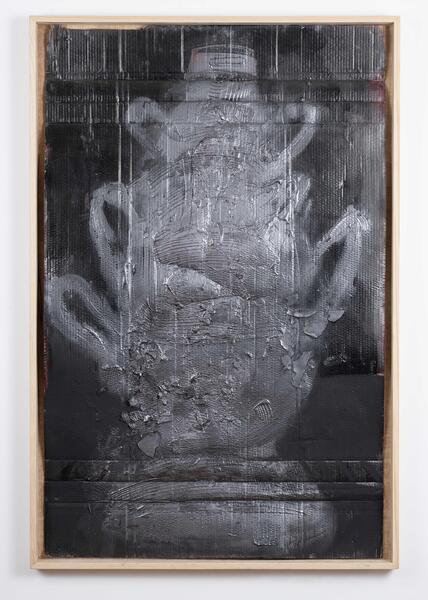 Trophy, 2023
Trophy, 2023Trophy, 2023
Acrylic, charcoal, ink, graphite powder on corrugated cardboard in wooden shadowboxes, ca. 64x40”
-
In Memory (l), Mnemosyne (r), each created with charcoal, ink, graphite powder on corrugated cardboard, ca. 64x40”, 2021
In Memory (l), Mnemosyne (r), 2021
Each created with charcoal, ink, graphite powder on corrugated cardboard, ca. 64x40”,
MONO-POL-LITHIC
The second set “Die Lichtung”/“The Clearing”, charcoal on paper, 24x36” The idea of „The Clearing“ refers to distorted urbanization of dense jungle of signs in a liminal state of disorientation. While I find clarity and enlightenment in the natural world, deforestation, devastating land seizure, and developments create a bewildering and obscuring presence. Starting with a new series, I am interested in how political agencies have transformed and depleted the land and what kind of manifestations of architecture and structures of power are revealed. I would like to question how references between deep time, the lay of the land, and its monuments can be expressed today.
The third set of “XTrata”, “Amazon”, and “Gates”, charcoal on paper, 24x36” all big Corp. names reference Capitalocene and impact of deep time. Starting with a new series, I am interested in how political agencies have transformed and depleted the land and what kind of manifestations of architecture and structures of power are revealed. I would like to question how references between deep time, the lay of the land, and its monuments can be expressed today.
-
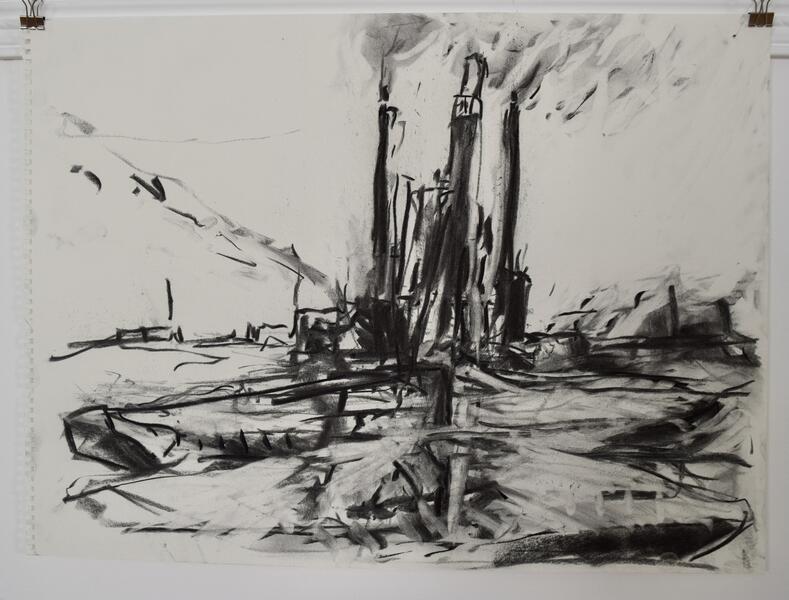 Monopol 3charcoal on paper 18x24” 2020
Monopol 3charcoal on paper 18x24” 2020 -
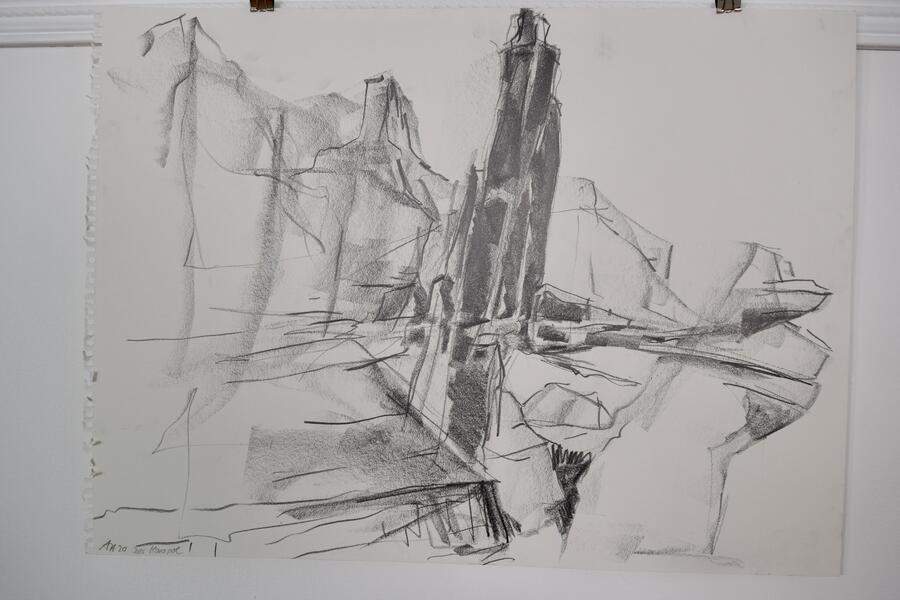 MonopolGraphite on paper 18x 24” 2020
MonopolGraphite on paper 18x 24” 2020 -
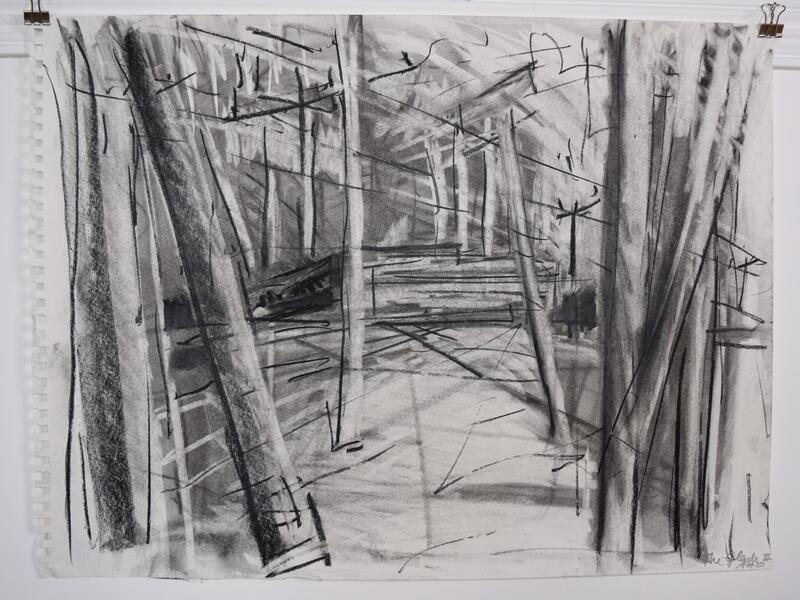 Glade1charcoal on paper 18x 24” 2020
Glade1charcoal on paper 18x 24” 2020 -
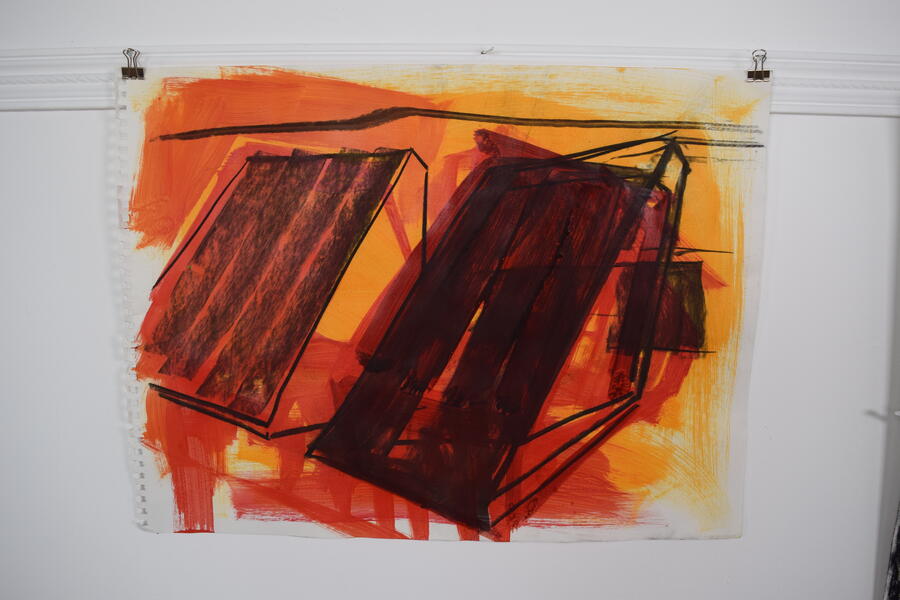 Detention 16mixed media (charcoal, graphite, oil pastel/tempera, wax) on paper 9x 11” 2020
Detention 16mixed media (charcoal, graphite, oil pastel/tempera, wax) on paper 9x 11” 2020 -
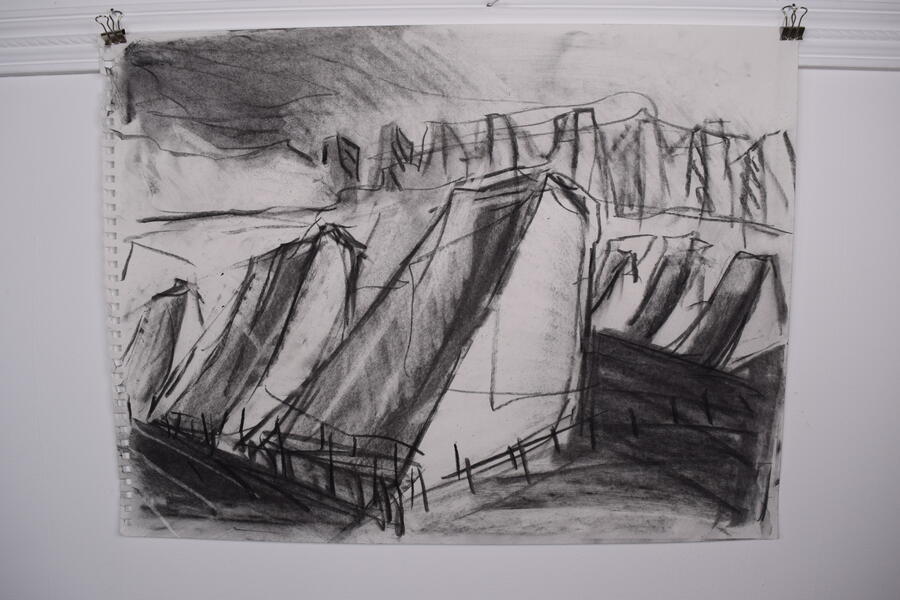 Detention 6charcoal on paper 18x 24” 2020
Detention 6charcoal on paper 18x 24” 2020 -
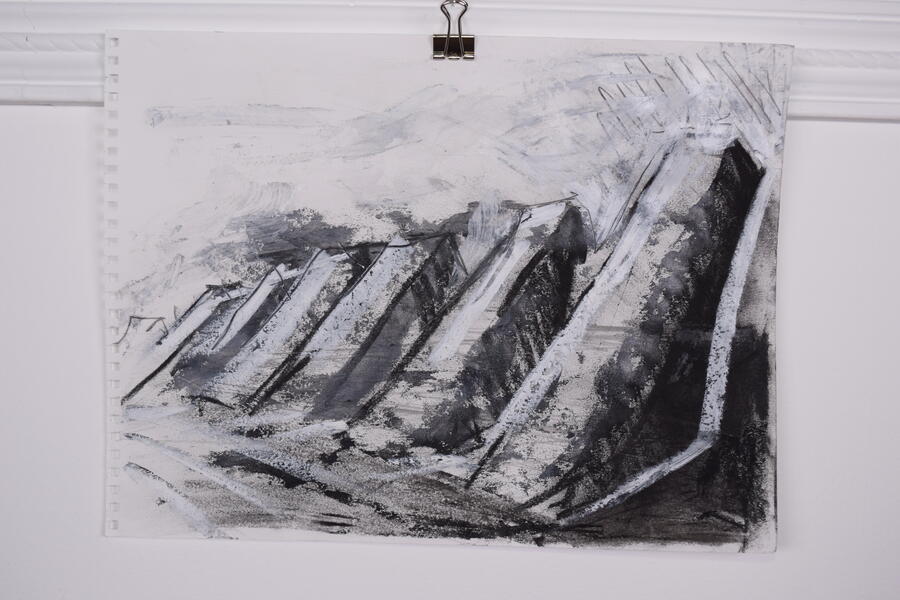 Detention 9mixed media (charcoal, graphite, oil pastel/tempera, wax) on paper 9x 11” 2020
Detention 9mixed media (charcoal, graphite, oil pastel/tempera, wax) on paper 9x 11” 2020 -
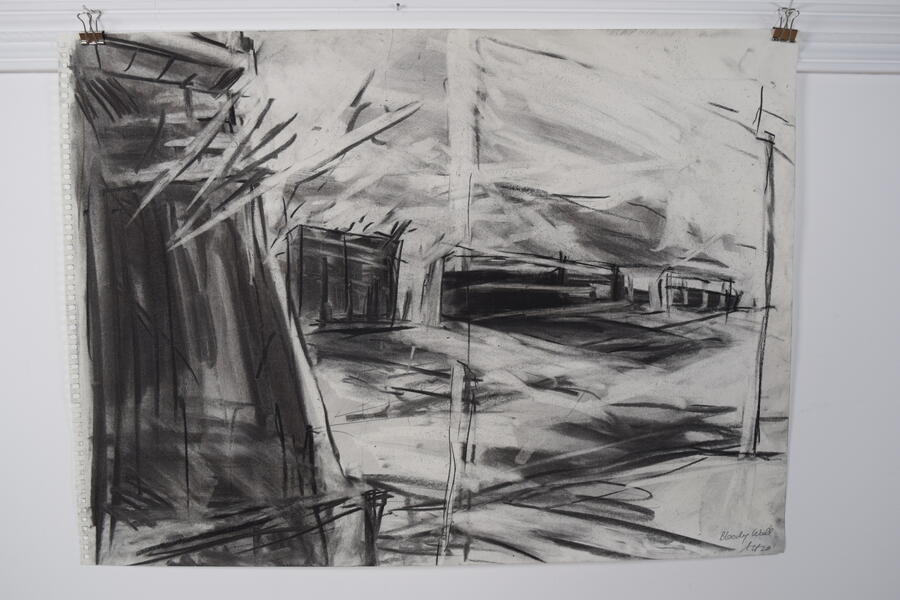 The Bloody Wall 2charcoal on paper 18x 24” 2020
The Bloody Wall 2charcoal on paper 18x 24” 2020 -
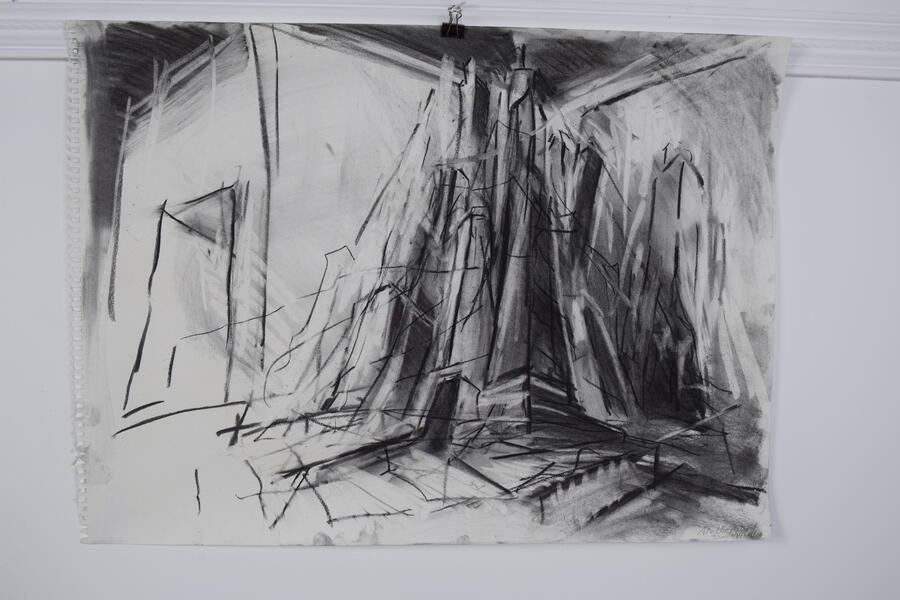 Tower Meetingcharcoal on paper 18x 24” 2020
Tower Meetingcharcoal on paper 18x 24” 2020 -
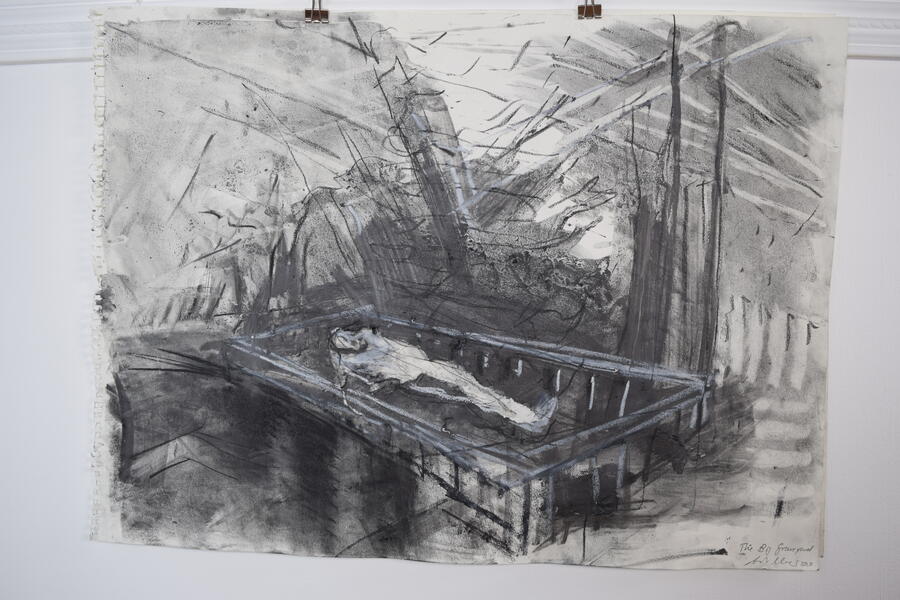 The Big Graveyardcharcoal on paper 18x 24” 2020
The Big Graveyardcharcoal on paper 18x 24” 2020
GAIA RISE
of eighteenth century sturm und drang, with a touch of Caspar David Friedrich’s (1774–1840) Romanticism blended in. Herber is clearly inspired by Kiefer’s confluence of history and landscape. Both work on a spectacular, grand scale, looking both forward and back. While Kiefer employs unconventional materials such as lead and straw, the densely layered surfaces of Herber’s tactile landscapes are built up with dirt, charcoal, and marble dust. Out of ecological consideration, Herber’s “canvas” is recycled, corrugated cardboard. She reuses other materials such as a mop, honeycomb, a woman’s nightgown, all repeatedly wet, wrung out and reassembled. This process, and the curved, enveloping, cyclorama presentation of the paintings, reinforces the theme of tectonic history repeating in an endless cycle of creation and destruction. In Herber’s work, time is mythic and geologic.
-
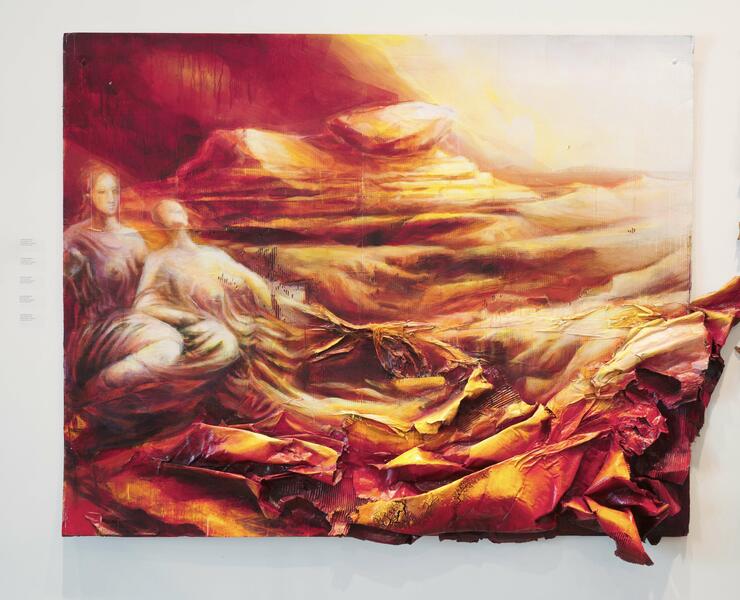 Gaia's MemorySeries of Gaia Rise Acrylic and mixed media; layers of watered, wrung out and unfold sheet of corrugated cardboard, rearranged and applied on corrugated cardboard 90x5x115” 2019 The two female figures references from the Parthenon Frieze at the British Museum, London. During theCoLAB Historic Residency I took the opportunity to explore Gaia myth and female powers in connection with aspects of geologies and deep time. Gaia’s Memory, also known as the Muse Mnemosyme, is Gaia’s daughter. Some scholars alternatively suggest that oldest Titan deities might have been carved into the Parthenon Frieze and contradiction Hesiod’s assumptions. “Gaia’s Memory” suggests speculations about female powers placed and carved into deep time while revealed through an ongoing artistic practice of multilayered re-/arrangements of an unfolding and dynamic landscape.
Gaia's MemorySeries of Gaia Rise Acrylic and mixed media; layers of watered, wrung out and unfold sheet of corrugated cardboard, rearranged and applied on corrugated cardboard 90x5x115” 2019 The two female figures references from the Parthenon Frieze at the British Museum, London. During theCoLAB Historic Residency I took the opportunity to explore Gaia myth and female powers in connection with aspects of geologies and deep time. Gaia’s Memory, also known as the Muse Mnemosyme, is Gaia’s daughter. Some scholars alternatively suggest that oldest Titan deities might have been carved into the Parthenon Frieze and contradiction Hesiod’s assumptions. “Gaia’s Memory” suggests speculations about female powers placed and carved into deep time while revealed through an ongoing artistic practice of multilayered re-/arrangements of an unfolding and dynamic landscape. -
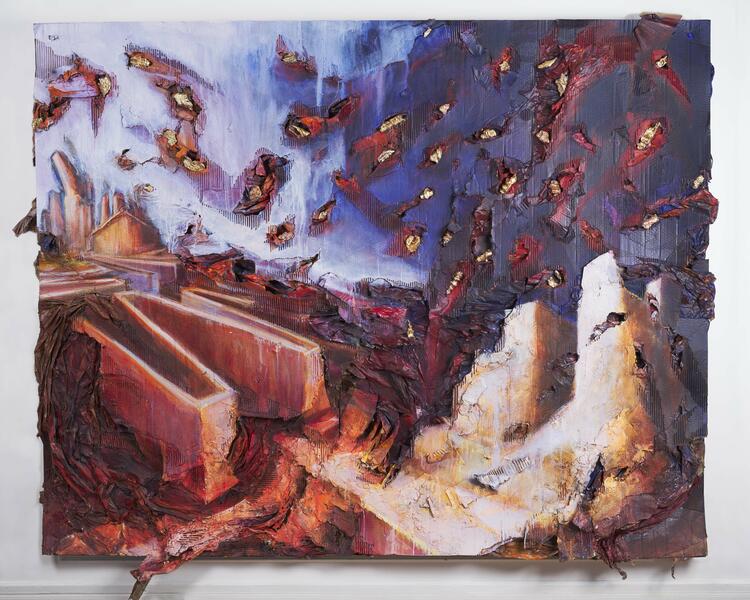 PerseidsSeries of Gaia Rise Acrylic and mixed media; molded hand in-prints, gold embellished, incorporated into multilayered corrugated cardboard and packing paper 85x3x100” 2019
PerseidsSeries of Gaia Rise Acrylic and mixed media; molded hand in-prints, gold embellished, incorporated into multilayered corrugated cardboard and packing paper 85x3x100” 2019 -
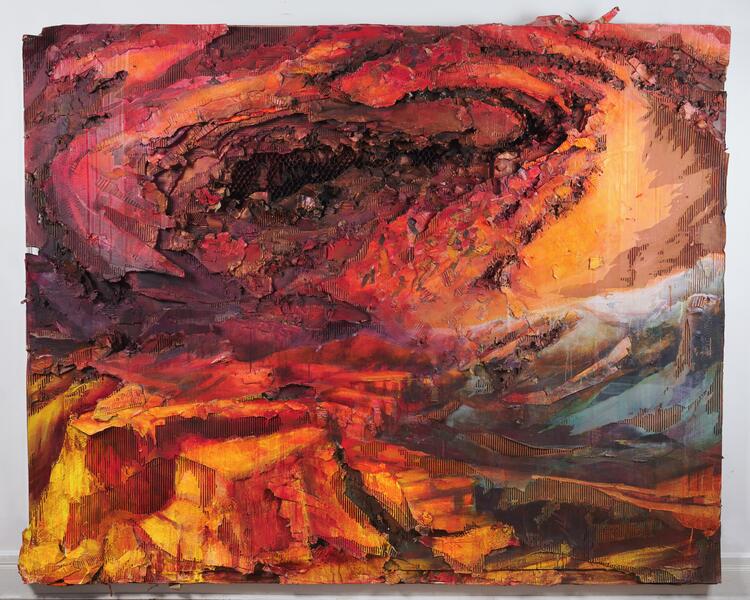 MelancholiaSeries of Gaia Rise Mixed media (acrylic, coal pigments, shellac, honeycomb, packing paper) on corrugated cardboard, glued together and partially hammered out digging holes into the accumulated material, washed paint, filled coal pigments, continuous collaging/de-collaging, disintegration and reconstruction 90x3x100” 2020 The title of “Melancholia” refers to Lars von Trier’s film, in which we see Earth aligned with a red, planet that turns out to be Melancholia. This radical slow-motion evokes the paralysis of chronic depression, while the planet is hurtling toward Earth and its impact will destroy all human life. With my painting “Melancholia” I wanted to convey an underlying tale of environmental concerns embedded in tectonic activities that shape and change our landscapes over short period time that threatens our vulnerable biosphere. I recycle used and found cardboards and materials (coal, concrete, marble, pigments, and other findings as expressions of our metabolic regimes) and compress time from “slow motion” of the Industrial Evolution era until today with the urgency of disconcerting news about the Amazon (California, Australia) fires as indicators of ongoing changes of our biosphere caused by extortion, exhaust, mining, monoculture, and neglect of endless ends on Earth through economic driven political decisions.
MelancholiaSeries of Gaia Rise Mixed media (acrylic, coal pigments, shellac, honeycomb, packing paper) on corrugated cardboard, glued together and partially hammered out digging holes into the accumulated material, washed paint, filled coal pigments, continuous collaging/de-collaging, disintegration and reconstruction 90x3x100” 2020 The title of “Melancholia” refers to Lars von Trier’s film, in which we see Earth aligned with a red, planet that turns out to be Melancholia. This radical slow-motion evokes the paralysis of chronic depression, while the planet is hurtling toward Earth and its impact will destroy all human life. With my painting “Melancholia” I wanted to convey an underlying tale of environmental concerns embedded in tectonic activities that shape and change our landscapes over short period time that threatens our vulnerable biosphere. I recycle used and found cardboards and materials (coal, concrete, marble, pigments, and other findings as expressions of our metabolic regimes) and compress time from “slow motion” of the Industrial Evolution era until today with the urgency of disconcerting news about the Amazon (California, Australia) fires as indicators of ongoing changes of our biosphere caused by extortion, exhaust, mining, monoculture, and neglect of endless ends on Earth through economic driven political decisions. -
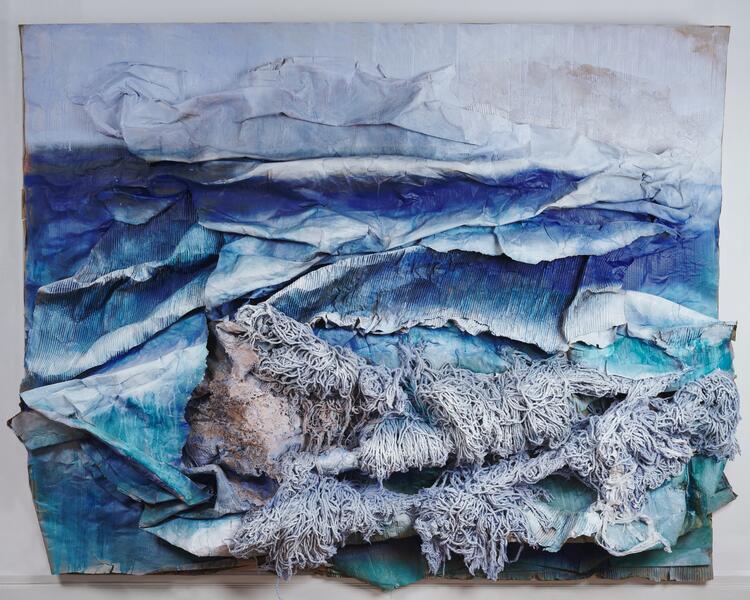 Medusas RapeSeries of Gaia Rise Acrylic and mixed media; commercial cleaning mop heads, incorporated into multilayered corrugated cardboard and packing paper 90x10x100” 2019 Among others, I include the snake hair monster Medusa as an extended Gaia version allowing to expose female deities that are commonly marginalized as terrifying powerful women. As an ongoing commitment, I reconnect empathically with Medusa. Giving back women their grandeur and dignity with In playful, shrill and opulent imagery and wildly intertwining gesticulations of vivid brushstrokes and material use, I seek to untie misogynist iconography fusing political and societal injustice with images of the power of elements in nature. I propose polit-myth as an artistic strategy to seek a paradigm shift towards political decision that are motivated by environmental concerns of climate change caused by human activity that are rooted in myths and histories.
Medusas RapeSeries of Gaia Rise Acrylic and mixed media; commercial cleaning mop heads, incorporated into multilayered corrugated cardboard and packing paper 90x10x100” 2019 Among others, I include the snake hair monster Medusa as an extended Gaia version allowing to expose female deities that are commonly marginalized as terrifying powerful women. As an ongoing commitment, I reconnect empathically with Medusa. Giving back women their grandeur and dignity with In playful, shrill and opulent imagery and wildly intertwining gesticulations of vivid brushstrokes and material use, I seek to untie misogynist iconography fusing political and societal injustice with images of the power of elements in nature. I propose polit-myth as an artistic strategy to seek a paradigm shift towards political decision that are motivated by environmental concerns of climate change caused by human activity that are rooted in myths and histories. -
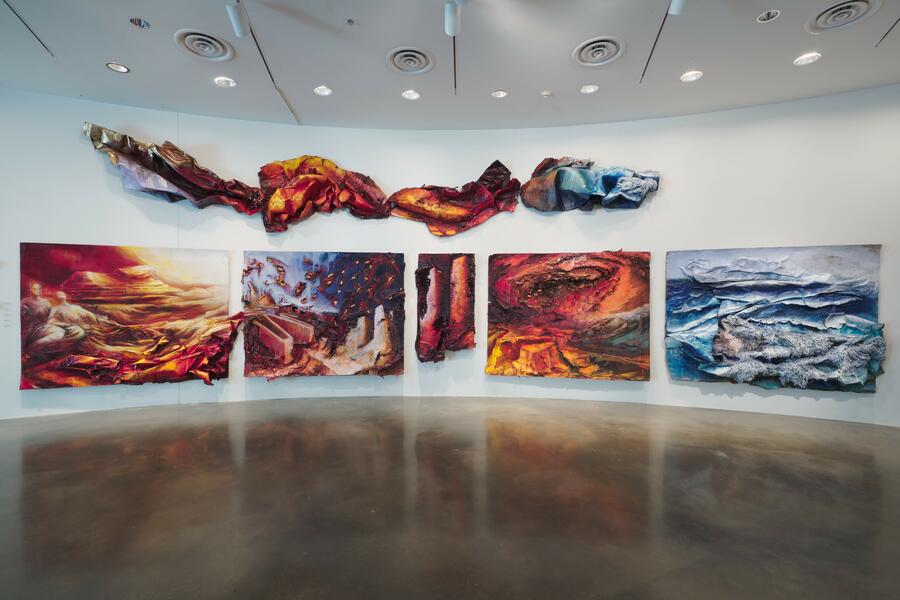 Gaia Cycle Panorama
Gaia Cycle Panorama
Autochthon
The series of Authochthon points to my interest in Greek mythology and in human relationships to geologic forms. In mythology, autochthones are mortals who have sprung directly from the soil, rocks, and trees. In structural geology, an autochthon is a mass of rocks that remain rooted to the foundation on which it was originally formed. This rootedness or sense of place stands in contrast to the destabilization wrought on the earth by human activity. With corrugated cardboard – a ubiquitous signature for our globalized consumerism – I connect the material and conceptual infrastructure of the work. I explore entanglements between deep time and changes in our natural, environmental, and historically grown landscapes that have the capacity to compress past and present.
-
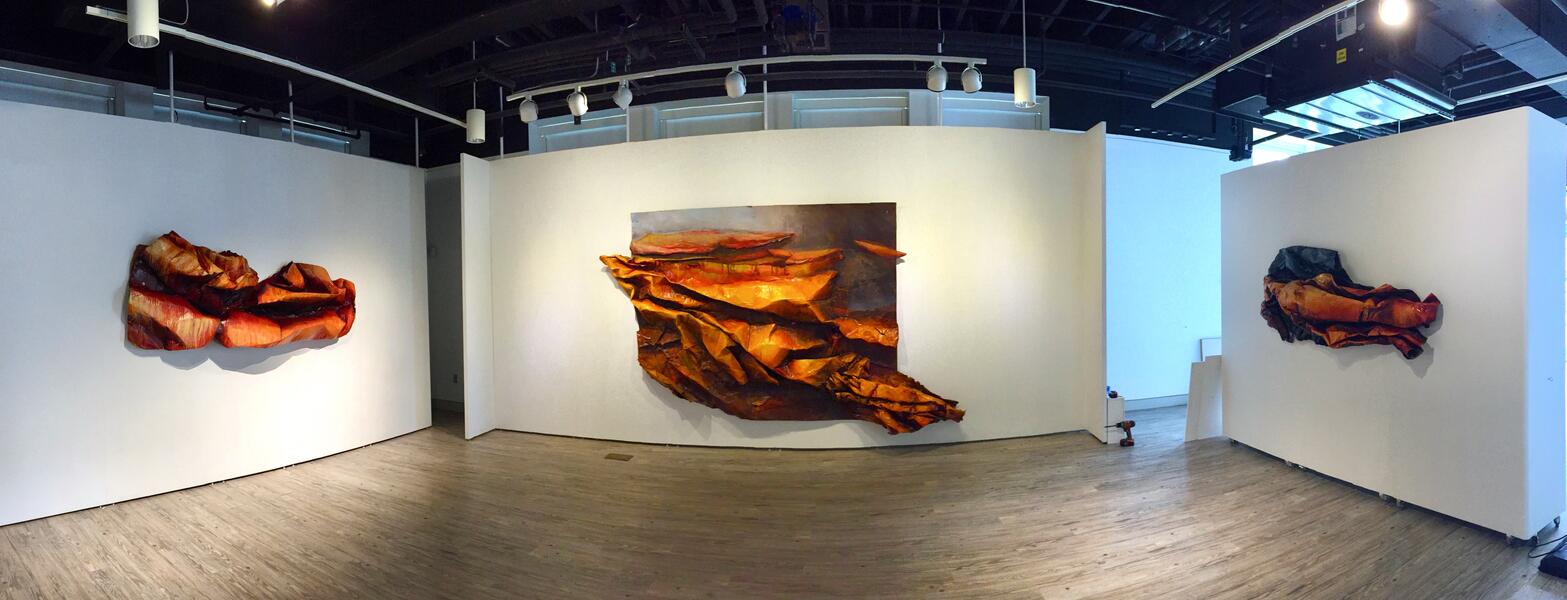 Autochthon
AutochthonAutochthon, 2018
Installation view of three works, Acrylic on corrugated cardboard, various sizes,
-
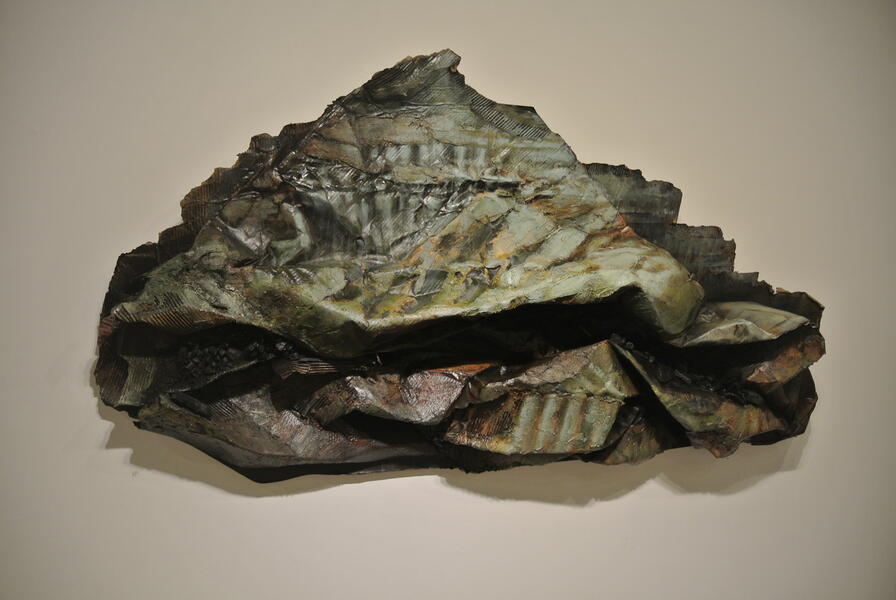 Earth Movers
Earth MoversAcrylic and mixed media (coal chips, charcoal, marble paste) on corrugated cardboard, 36x12x80”
-
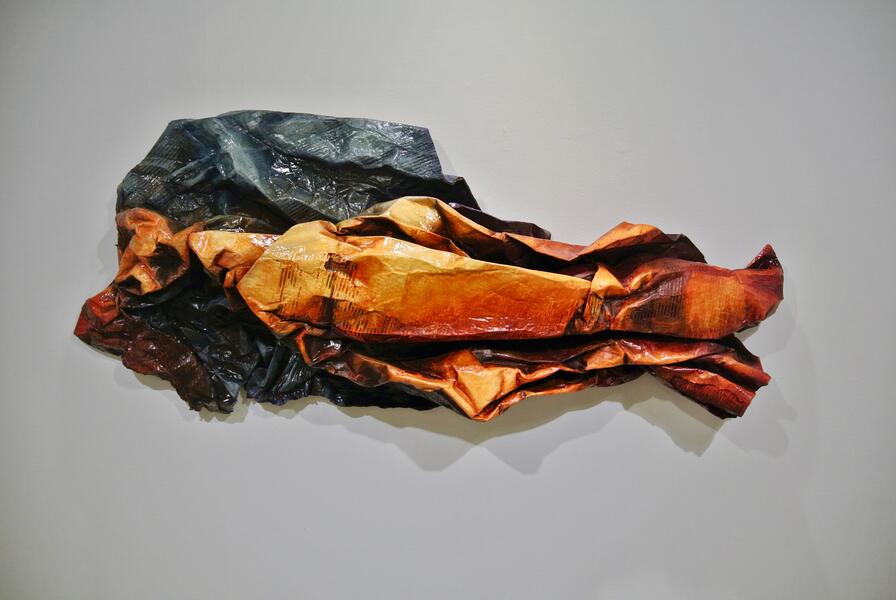 Autochthon II
Autochthon IIAcrylic on multilayered corrugated cardboard, 30x10x40", 2018
-
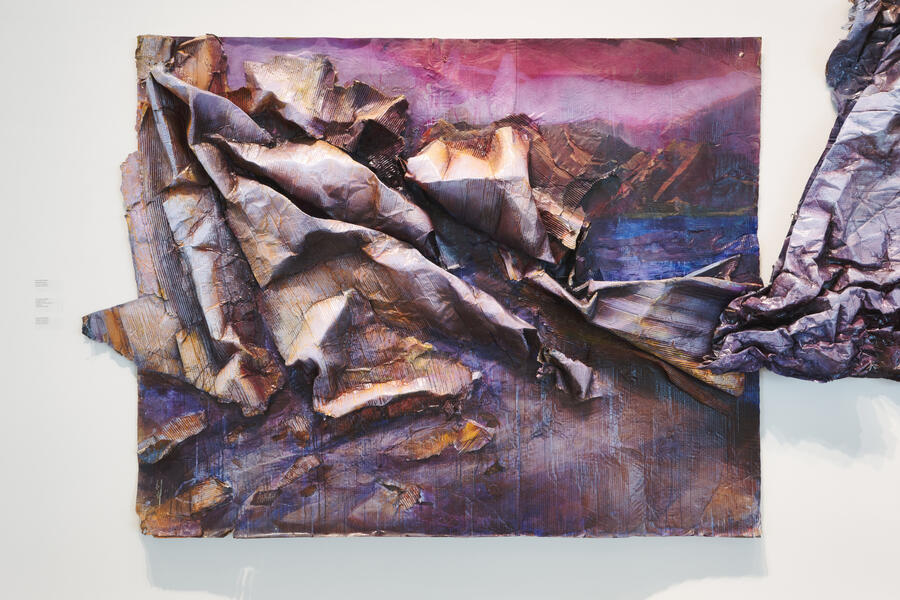 Symplegaden
SymplegadenSeries of Authochthon, Acrylic on corrugated cardboard, 95x12x”100”, 2018-2019
-
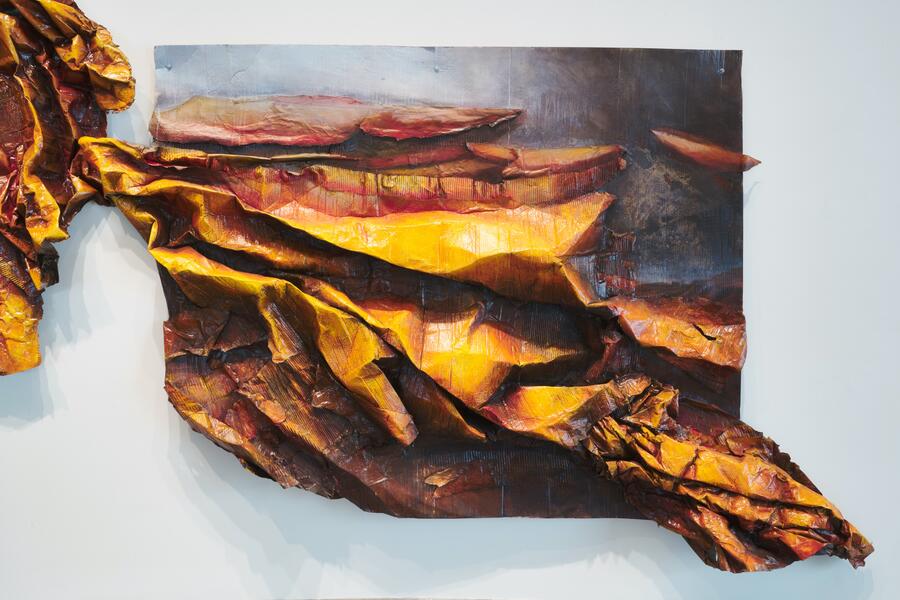 Wrinkles in Time
Wrinkles in TimeSeries of Authochthon, Acrylic on corrugated cardboard, 100x5x”120”, 2018
-
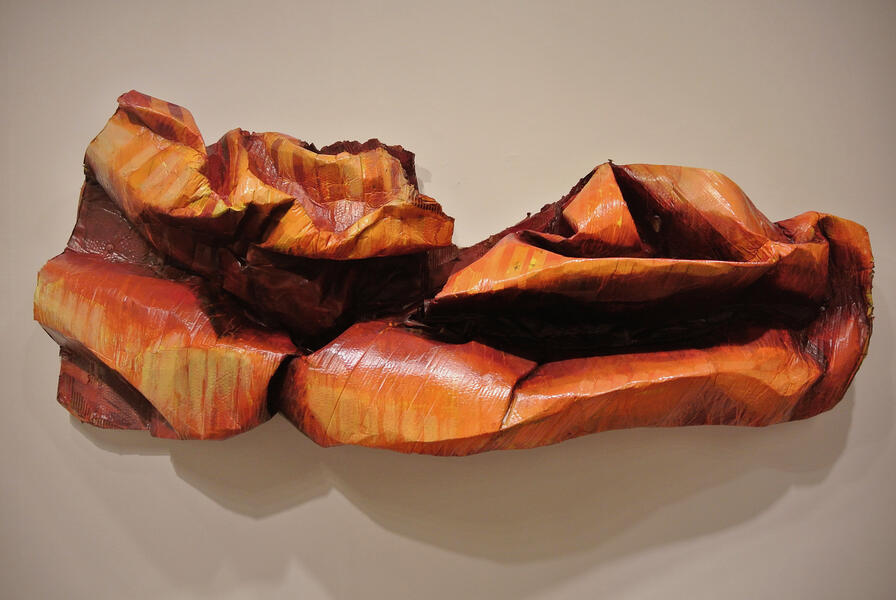 Autochthon I
Autochthon ISeries of Autochthon, Acrylic on multilayered corrugated cardboard, 36x90x12“, 2018
Erratic Landscapes
Erratic Landscapes refers to political volatility embedded in motifs of landscapes in precarious conditions attempting a metaphorical language that conveys aesthetic praxis confronting the problematic of temporalities and ends as an ongoing consideration of interconnections between art, politics and environment. They transformed into parables and metaphors of man’s intervention. There is an underscore of subjects in the vast field of land-seizure, exploitation and migration that form a movement between material and metaphor into meaning issuing geopolitical issues deriving from deep-time, history towards concerns of migration and immigration, loss of home and separation. POLYPHEMUS - AFTER CASTING THE ROCK, PERSEPHONE’S LAMENT and GOLDEN SPIKE reflect on various intersections between ancient times and relevance of myths to the current condition on planet Earth.
-
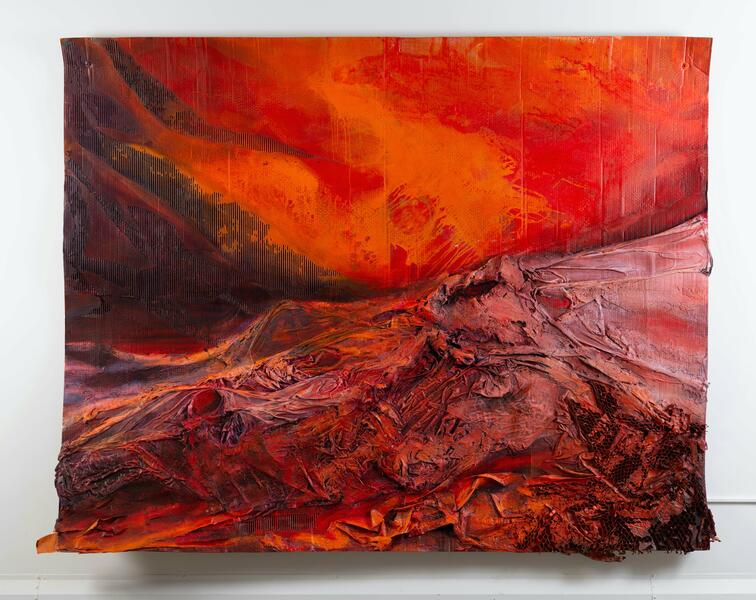 Persephone's Lament
Persephone's LamentPersephone’s Lament, 2018
Acrylic and mixed media, female nightgowns, fabrics and linen, marble powder, honeycomb on corrugated cardboard, 95x100”
“Persephone” is an installation that embodies the mythological and ecological duality of Persephone, the goddess who bridges the realms of the underworld and spring’s renewal. The bold striped tectonic structures in the piece contrast with the organic forms created through the layering and manipulation of materials like coal and recycled cardboard, symbolizing the tension between human intervention and nature’s resilience. The composition reflects Persephone's mythological story, representing her role as both a chthonic deity and a figure of rebirth. Her enwrapped form evokes the liminal states of transformation, both geological and personal, as she transitions between realms. This interplay of materials mirrors humanity’s exploitation of the Earth’s strata—cutting, tearing, and extracting—while also hinting at reconstruction and hope. Through a visceral layering process, the sculpture invites viewers to consider their own relationship to the cycles of nature, death, and regeneration.
-
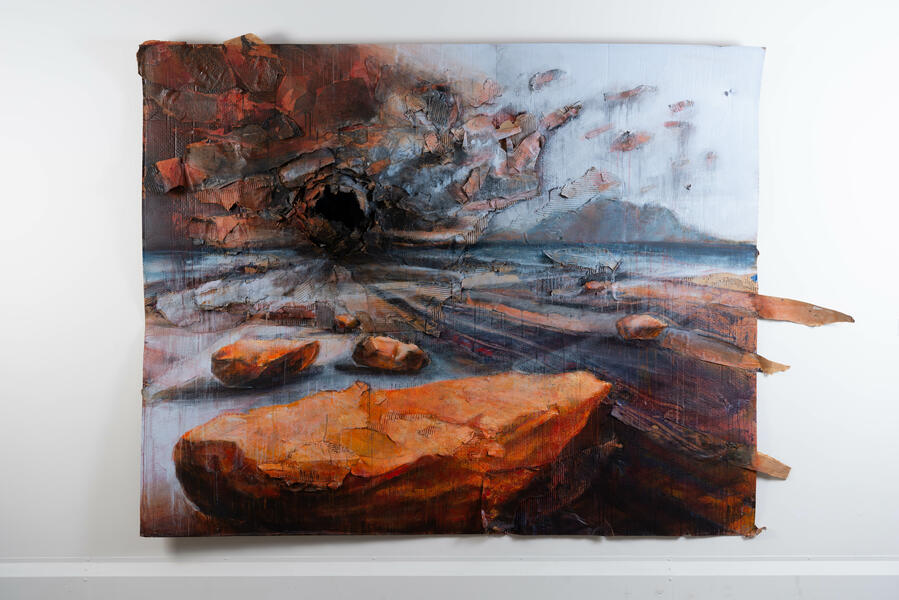 Polyphemus – After Casting Rocks
Polyphemus – After Casting RocksA parable about the Philoxenia, a deeply rooted hospitality for foreigners and the rise of Xenophobia
Even the earliest literary testimonies of Greco-Roman antiquity reflect fleeing fates. The fact that refugees today, when they have finally arrived somewhere, speak of an "odyssey" that they had to go through points to one of the oldest texts. Homer's Odyssey reflects on the culture of hospitality and welcoming foreigners. In continuation, in Greece and in Rome there was already the institution of asylum coupled with a hospitable openness to strangers. My painting is an updated version about Odysseus as an traveller who is lost and encounters how tabus of hospitality have been broken, when he stranded at the island of the Cyclops. Instead, Philoxenia is deeply rooted in Greek culture as we have evidence of the Homeric epics that provide various ideal exemplary patterns as well as counter-images of ethical norms. Such a counter-image is revealed in the story of Polyphemus. On his wanderings Odysseus gets again and again in critical situations. As a stranger he is exposed to the goodwill of the hosts. The story of Polyphemus’ encounter with Odysseus, which is also at the center of the adventure, makes this particularly clear. Hospitality in ancient understanding did not need a name immediately. The first steps took place in a cultured sphere of anonymity, a phenomenon not only witnessed to the Greek world. The Celts behaved the same way. The Old Testament also provides examples of the Arab world.
-
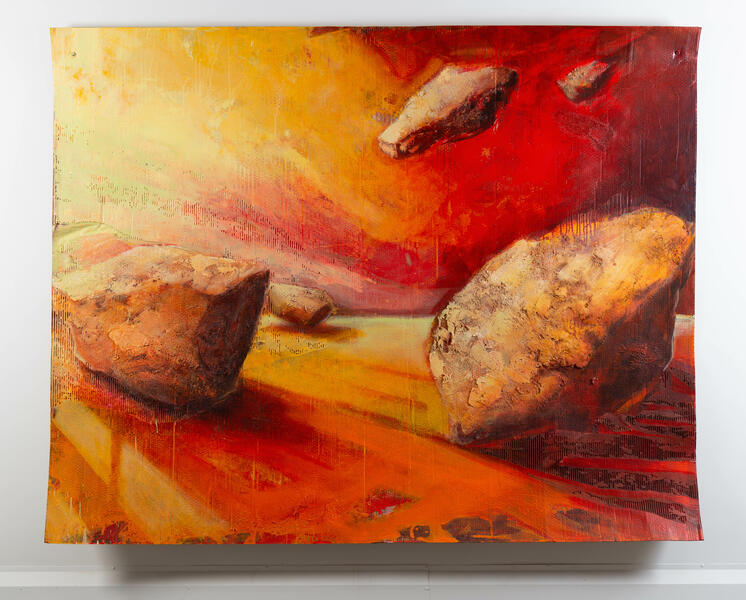 Universal Travelers
Universal TravelersUniversal Travelers, 2018
Acrylic and mixed media, marble powder, shellac, crackle paint on corrugated cardboard, 95x100”
My Painting relates to our current turbulent landscapes shaped by human activity and questionable political decisions of erratic nature. With “Erratic Landscapes” I address geo-economic and -political issues within the entanglement of deep time investigations, ancient myths, or anthropogenic intersections between time, the use of land, and global settings. "Universal Travelers" generate erratic imaginaries that create a pattern language of the long history of nomadism, migration and today’s discussions and issues upon immigration. Through my research into diverse aspects of the Anthropocene, evident landscapes are transformed into metaphors of how we use, take, claim and demand land without respecting human passages, travel and free movement as a human right. "Erratic", a metaphors as an utopian vision will challenge the idea of no borders at all, questioning the necessity of confinement in a world of global citizens, and engaging a discussion about the idea of global freedom of movement as a human right.
-
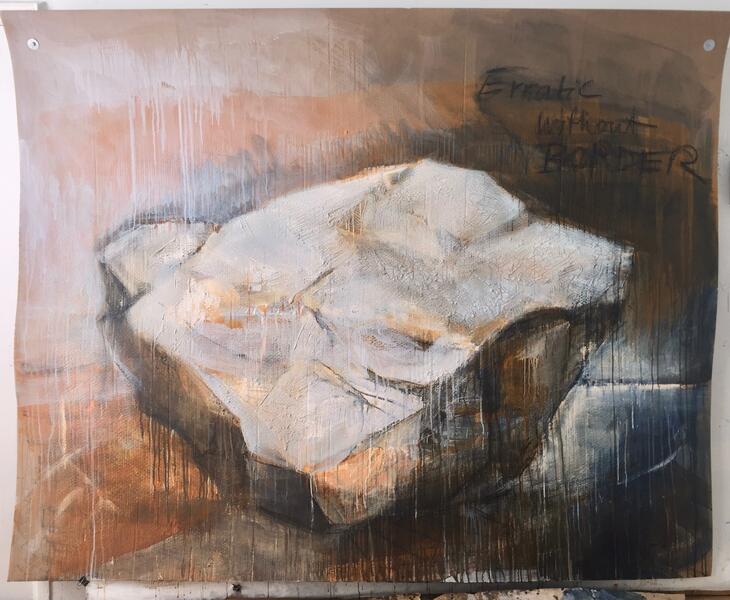 Erratic without Border, 2018
Erratic without Border, 2018Acrylic and mixed media, marble powder on corrugated cardboard, 95x100”
"Erratic without Border" from the series of "Erratic Landscapes" generates erratic imaginaries that create a pattern language of the long history of nomadism, migration and today’s discussions and issues upon immigration. Through my research into diverse aspects of the Anthropocene, evident landscapes are transformed into metaphors of how we use, take, claim and demand land without respecting human passages, travel and free movement as a human right. Saying that I also address geo-economic issues and unsettling political measures regarding colonialism, nationalism, the use of land, ownership, and global settings.
-
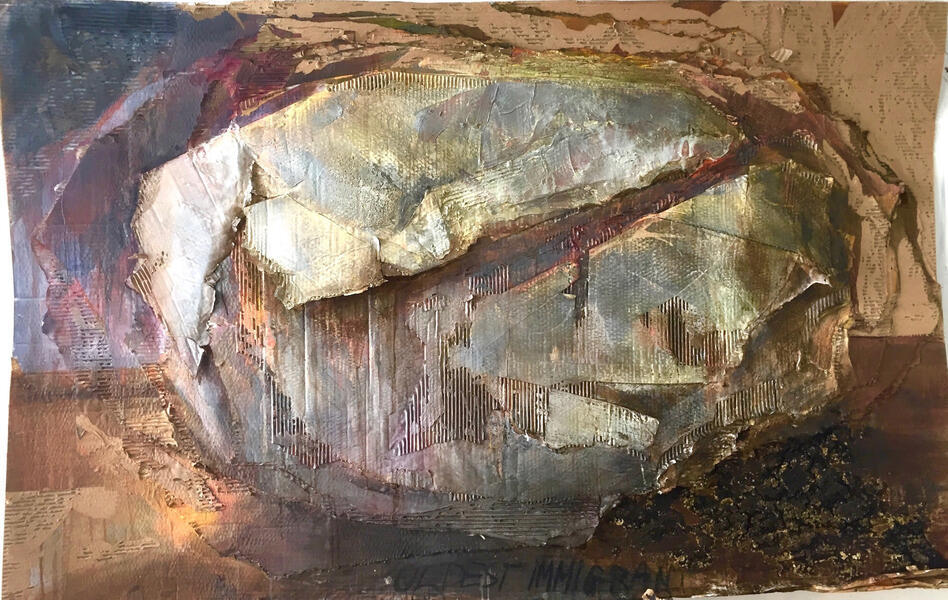 Oldest Immigrant
Oldest ImmigrantI understand an “erratic” as our “oldest Immigrants” that form a movement between material and metaphor into meaning issuing geopolitical issues deriving from deep time, history towards concerns of migration and immigration, loss of home and the search for a safe harbor in the world. Used as evidence to the geologic history of a place or its place of origin, “Oldest Immigrant” reveals history and narrative as a natural and cultural landmark that changes over time and cultural perception. The erratic as '"Oldest Immigrant" is inspired by the stories it tells us about places of origin, current position, visual appearance or characteristics, an actual piece of rock that carries attributions or personalized characteristics of a living thing.
In those moments when we as admirers, visitors, climbers or researchers connect with such an “individual thing”- an erratic - that traveled over passages and time, it tells us stories revealed through history or by people who dedicated their curiosity and scientific interest into deep geological time unfolding our present and future condition on Earth at this point. As boulders are scattered across vast landscapes left behind after many of them left behind after the Ice Age the land is characterized and formed as a result of massive environmental changes. Doreen Massey[i] refers to a campaign issuing immigration rights in Hamburg, Germany, where a largely accepted boulder is claimed as “our oldest immigrant,” after its glacial shift from modern day Sweden. Those campaigns question “the stability of the very land upon which their claims where made
[i] Massey, D. (2006). Landscape as a Provocation; Reflection on Moving Mountains (Journal of Material Culture 11).
[i] Hutton, J. (2013). Erratic Imaginaries Architecture in the Anthropocene. Open Humanity Press. p. 112
-
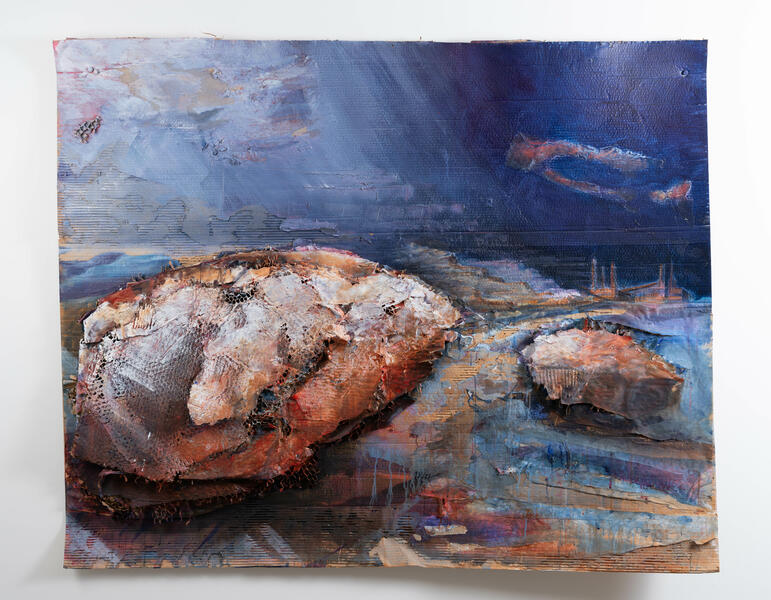 Dispelled
DispelledDispelled, 2018
Mixed media (acrylic, sand, coffee, honeycomb, packing paper) on corrugated cardboard layers, carved and cut surface of cardboard, torn, peeled, revealed, reassembled revealing and shaping relief-like textures to enhance ‘boulders’ in the foreground in contrast with the mining pit in the back, 40x60”
Beside of themes of singular erratic formations or boulders, I explore motives related to waterfalls, glacial pavement, cracks, cliffs caused by translated force from bedrock formations into architecture. Thereby I form intersections of current geo-terrestrial issues on planet Earth. "Dispelled" describes in general conditions of landscapes with alleged stability caused by human activity through extortion and exhaustion of the land. In this context I make use of a metaphorical language that conveys aesthetic praxis while confronting the problematic world of impermanence and its means to an end as an ongoing consideration of interconnections between art, politics and the environment.
Shifting Identities/Humanity in Nature
-
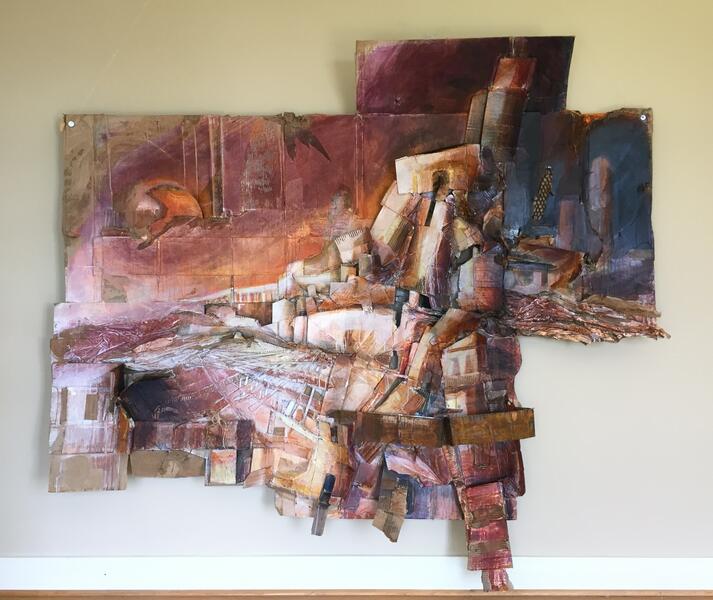 Eleusis
EleusisEleusis, 2015
Acrylic, found boxes, mixed media on corrugated cardboard, 95" x 100"
"A city, as a thing that is made of or on geology.
Idea of the city as a thing that makes geology.
What do rocks say and bones tell us?"
(Excerpt from my sketchbook)
The Eleusinian Mysteries were initiations held every year for the cult of Demeter and Persephone in ancient Greece. These events were understood to be among the most important secret religious rites. Their basis was an ancient matriarchal agrarian cult, possibly dating to the Mycenean period. Motivated by the shocking destruction at Palmyra, I started to investigate cultural sites of my Greek heritage through research of historic maps, cartographies and historic images of ancient sites intertwined with collected memories from travels and excursions translated into my own artistic expressions of my large-scale paintings. More specifically I investigated those historic sites that are affected by conditions of industrialized sites or neglect. Eleusis, about 18 kilometers northwest of Athens, is a major industrial center, with the largest oil refinery in Greece.
-
Mykene
Mykene, 2016
Acrylic on multilayered corrugated cardboard boxes, unfolded and de-collaged, 95" x 100”
Mycenae is an archaeological site located between two hills on the Argolid plain of Peloponnese, Greece. Between 1600 and 1200 B.C. it was one of the greatest cities of the Mycenaean civilization that dominated the eastern Mediterranean world and played a vital role in the development of classical Greek culture. The decline of Mycenae occurred after repeated damage from natural disasters such as floods, fires or earthquakes. My painting, titled Mykene, evokes surrounding generations of urban settings that seem familiar and yet come from another time. My images point to the future and talk about changes in our land use. They represent the energy of human creativity and the architectural mastery of space while temporal in time.
-
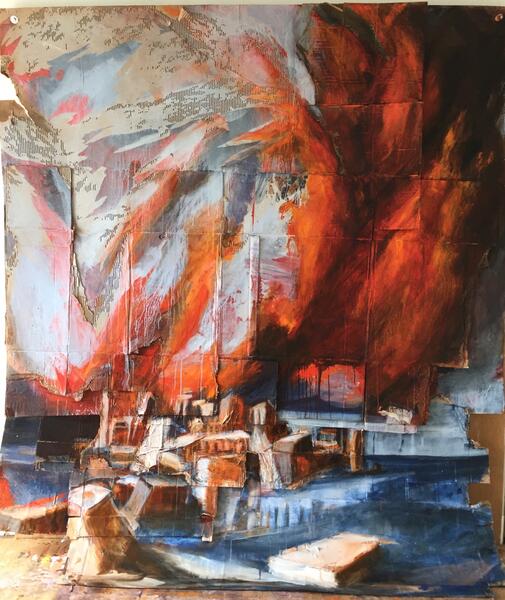 Kaldera
KalderaKaldera, 2015
Acrylic on corrugated cardboard, found boxes unfolded and re-assembled, 100" x 100”
My interest in cataclysmic events and the sudden disappearance of important ancient sites of my own and significant cultural heritage was the motivation for my exploration into the concept of Kaldera (or Caldera.) The island of Santorini is the site of one of the largest volcanic eruptions in recorded history: the Minoan eruption, which occurred some 3,600 years ago at the height of the Minoan civilization in the island of Crete. The eruption left a large caldera surrounded by volcanic ash deposits that was hundreds of meters deep and may have led to the collapse of the Minoan civilization on the island of Crete 68 miles to the south through a gigantic tsunami. Another popular theory holds that the Thera eruption was the source of the legend of Atlantis. Addressing the ongoing discussion regarding man-made disasters versus natural catastrophes, Kaldera connotes cataclysmic events in history (Hiroshima, WWI/II) and of today (9/11, Fukushima, or recent natural events such as hurricanes Sandy, Katrina, Harvey and Maria.)
My work reveals the entanglements of current geo-terrestrial issues on Earth. Erratic landscapes describe environments of alleged stability that appear precariously to come to an abrupt end or to be in a transitory state. I make use of a metaphorical language that conveys an ongoing consideration of interconnections between art, politics and the environment. I aim to link narratives and myths that are carved out and arranged as the tapestry of the human condition at stake. Art as a mediator helps us to understand ways to share our place on Earth in a more civic and empathic way.
-
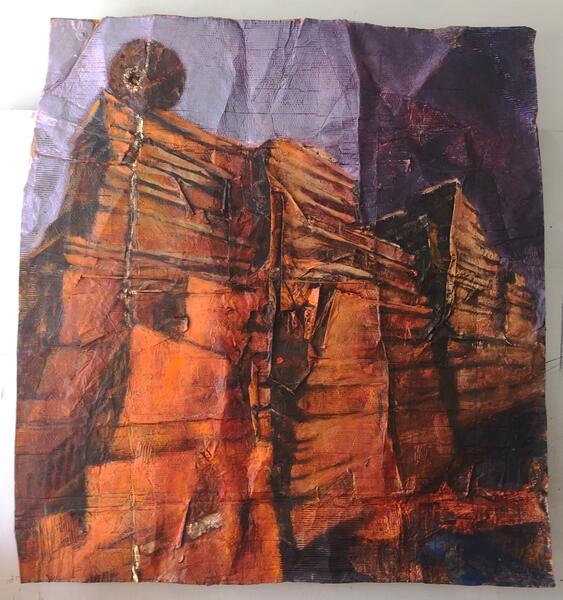 Golden Spike
Golden SpikeGolden Spike, 2016
Acrylic on corrugated cardboard, layers of cardboard and packing paper, 100" x 100”
-
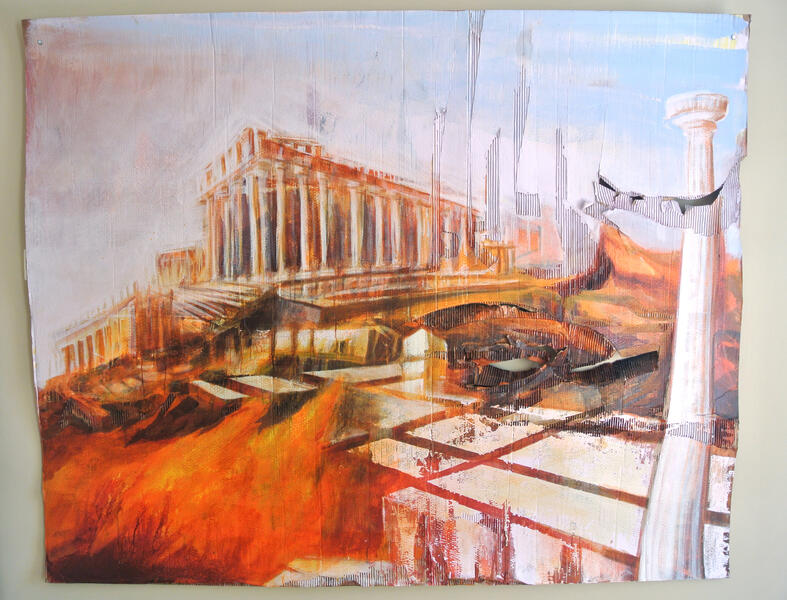 Herostratus
HerostratusHerostratus, 2015
Acrylic on corrugated cardboard, 95" x100”
Herostratus — or Erostratus — was a 4th-century B.C. Greek arsonist, who sought notoriety by destroying the Temple of Artemis, one of the Seven Wonders of the Ancient World. Mapping an ancient site of great cultic and geo-economic importance of that time, the site of the temple was sacred since the Bronze Age, going deep into geological layers of the Anthropocene. The Anthropocene refers to the Earth’s most recent geologic time period, defined as being human influenced or anthropogenic. It is based on overwhelming global evidence that atmospheric, geologic, hydrologic, biospheric and other earth system processes have now been altered by humans.
The title of the painting relates to the temple’s destruction in 356 B.C., by Herostratus who set fire to the wooden roof-beams, seeking fame at any cost. Inspired by current political conflicts in this painting I refer to his crime to point to a precarious political system spreading across the world like a fire.
Liminal States
-
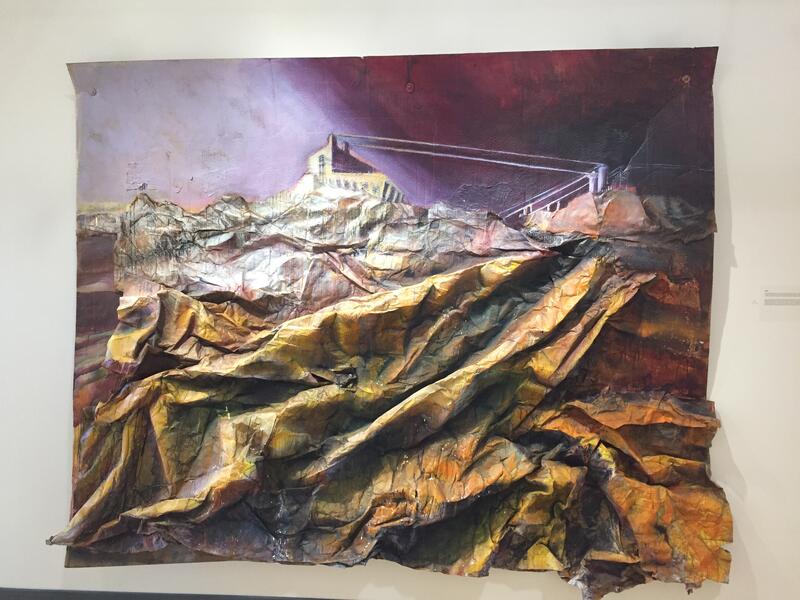 Big Pit
Big PitBig Pit, 2017
Acrylic on multilayered corrugated cardboard, 90" x 100"
This painting derived from series of "Erratic Landscapes", an attempt to create a body of work that has the capacity to represent geologic formations at all times while simultaneously giving an idea of the world with its complex intersections between art, aesthetics, geopolitics, and environment.
How do we view our Umwelt (environment) within the entanglement of energy harnessing and exploitation, its agents of production that in consequence lead to mass destruction, manufactured landscapes, disappearance of physical natural space, and reduction of oxygen in conclusion with cataclysmic events as a result of inevitable transformations on Earth? To answer these questions I investigate deep time with its layers and formations trying to understand what we can learn from the past that we not have lived yet.
-
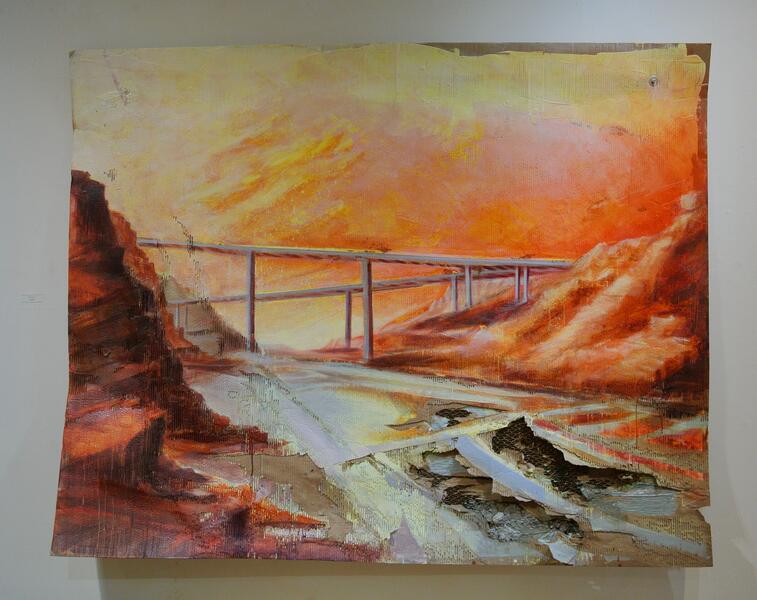 Aggregate
AggregateAggregate, 2018
Acrylic, mixed media and concrete on corrugated cardboard, 90' x 100"
-
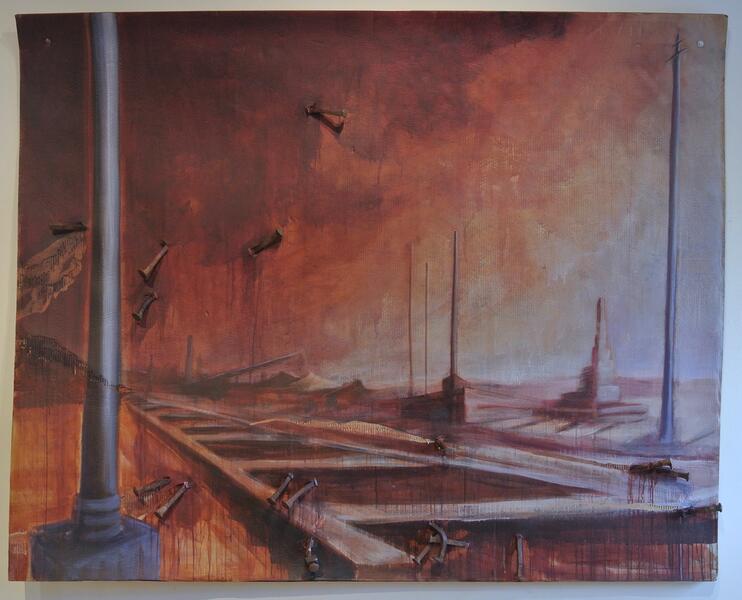 Deranged
DerangedDeranged, 2017
Painting, Acrylic, found rusty rail nails on corrugated cardboard
-
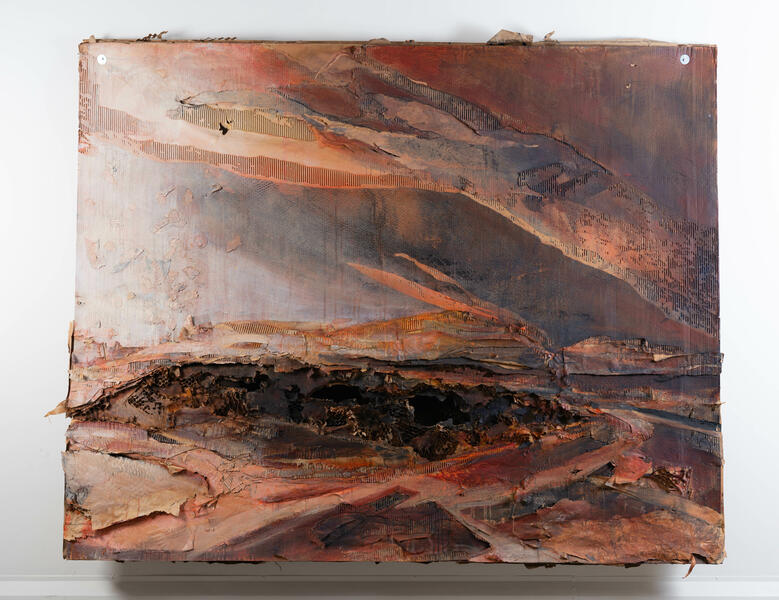 A Hole is Not a Hole
A Hole is Not a HoleA Hole is Not a Hole, 2018
Acrylic, mixed medium charcoal powder on multilayered corrugated cardboard
-
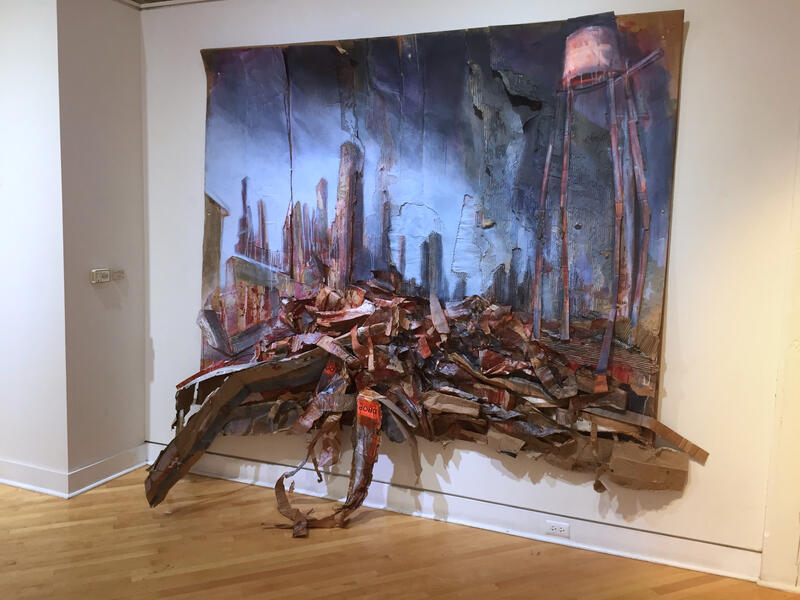 Slide
SlideSlide, 2015
Acrylic, found ripped boxes on corrugated cardboard, 100" x 110"
-
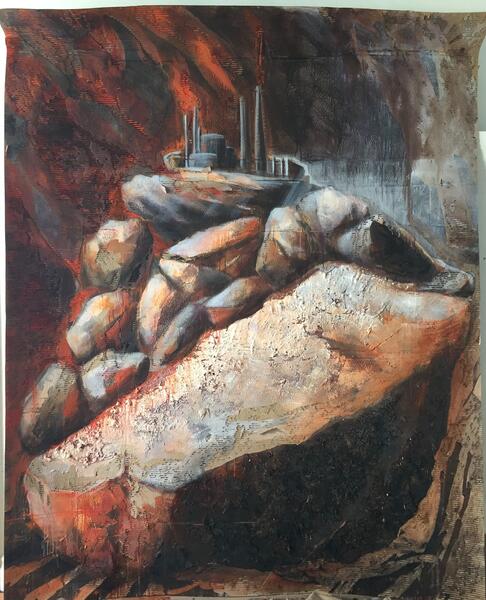 Last Rock Standing
Last Rock Standing -
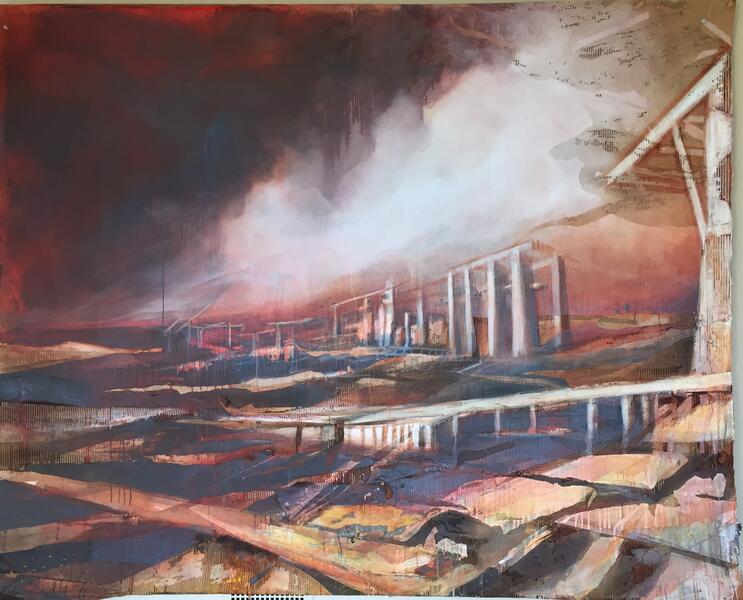 A New City
A New CityA New City, Acrylic on corrugated cardboard, 2014
Series of Nomansland, 95' x 100"
Similar to cataclysmic events in the past evolution and changes on Earth, but recently in a far shorter period of time of about 100 years, the human species has left a signature on Earth that marks the land in the way we have used it until today. The land shows the traces of colonization, urbanization, and migration that transformed and changed the human condition through developed exploitation of energy resources.
Humans stand at the threshold between a previous way of life and what their future outcome will become. I propose the idea of liminality through places of threshold such as arid climates, landscapes in transition, or in a state of neglect, devastation, or exploitation. Suggesting the idea of liminality in my work includes a pattern of language of sameness in landscapes referencing the work of philosopher Marc Augé who defined as places of threshold in urban places. Historical, political, and economically shaped environments are reflected in my works through commonplace settings that seem familiar and yet come from another time. The images are intended as witnesses from the future and talk about changes in our land use. They represent the energy and dynamics of human technocracy and the mastery of space, which also raises questions on how our will to shape the world will be directed.
With my work I demand hope and still possible change.
“The ends today are endless.” – Jean Luc Nancy
-
Pearls of the Sea
Pearls of the Sea, 2014
Acrylic on corrugated cardboard, folded and weathered for a year and unfolded, incorporated ragged tinted shirts, 100" x 100”
Ideas of liminality include “non-places,” as defined by Marc Augé, places of threshold and arid environments in transition that are revealed in the interaction between man and nature. Historical, political and economic shaped environments are reflected in my works through the generation of urban settings.
My travels to Marfa, TX and later to Abu Dhabi inspired impressions of the desert, plains and vast landscapes. At the shore of the Persian Gulf I observed how fast a city grows in just one day. I learned that the wealth of Abu Dhabi originally derived from pearl fishing; this before oil digging became the new source of capital gain, setting off a completely new economic development on the shoulders of slave work and human extortion. The entanglement between history and geo-economic activities is mainly expressed by using tinted rags, the color of the cheap labor workers’ uniforms and weathered cardboard that I picked up as a base for the painting.
-
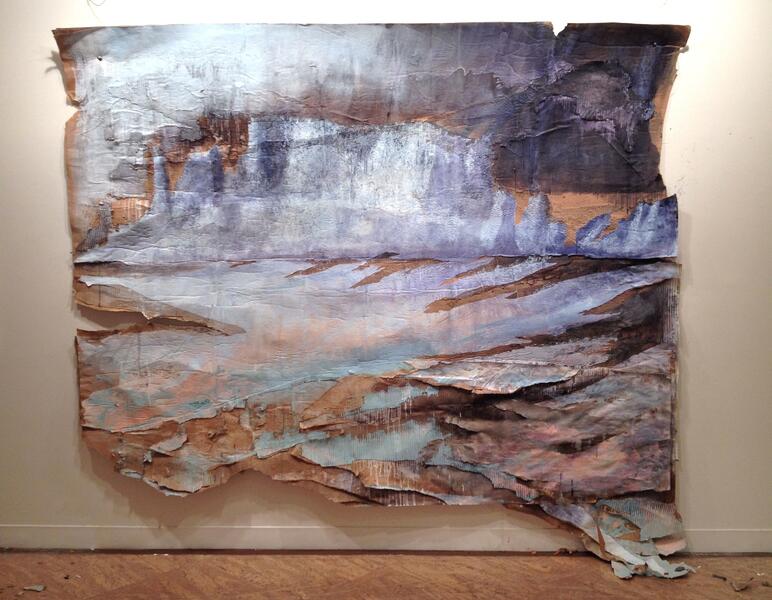 Vapor
VaporVapor, 2014
Series of No Man's Land, Acrylic on corrugated cardboard, 95" x 100”
My barren and deserted landscapes resemble places of exposure; it’s the place of surroundings and environs; or a hinterland. But it also includes ideas of a place of transition and purification; a journey for the soul. The series No Man’s Land suggests various directions within the concept of liminality. The painting Vapor indicates not just any a space but suggests a vast, cold, but also evaporating place on earth that generates its pure essence of its being with various geoeconomic, environmental, terrestrial and psychological notions.
-
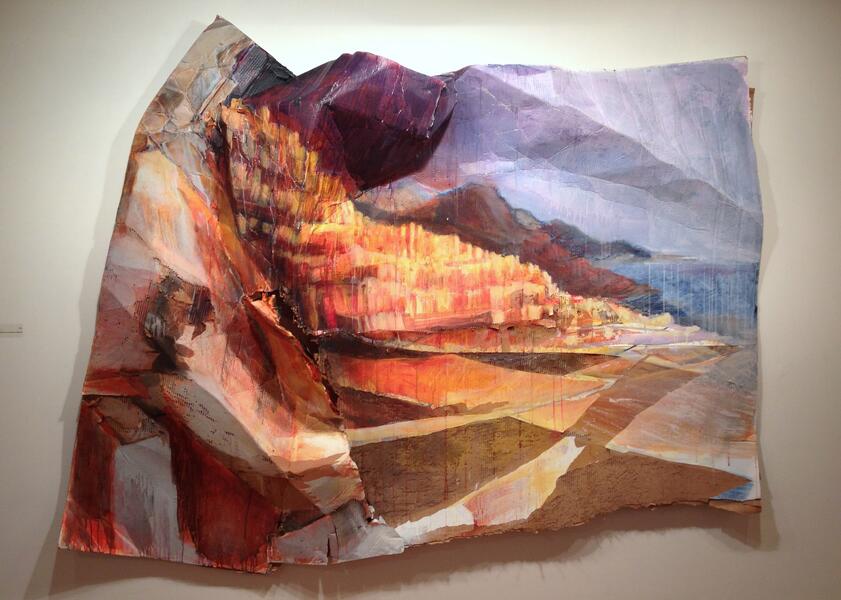 Quarry
QuarryQuarry, 2014
Series of No Man's Land, Acrylic on corrugated cardboard, ripped and rearranged, 85 x 20 x 100”
I examine the relationship between space and place, exploring urban environments empty of humanity and permeated with a sense of instability.
I paint cityscapes, forsaken places and ruined constructions on corrugated cardboard which I tear, batter and shape. Ragged cardboard sheet captures impressions of locales after storms, disasters or catastrophes. In accordance with three of similar works “Walls are Gone” created after the 2013 Rana Plaza garment factory collapse in Bangladesh. “Swept Away” in reaction to 2012’s Superstorm Sandy. “Tower City” refers to the terrorist attacks of 9/11, "Quarry" refers to top mountain moving and the depletion of sacred land.
My paintings represent aging, abandoned, crumbling surroundings through tears, cuts, shreds, revealing layers of corrugation, tattered textures, and dissolving surface conditions. Painted in a free manner, I still achieve a sure and exact rendition of details. At the same time I avoid a polished look of a painting, but prefer a rough and raw mode of spills and sketch-like gestures incorporating structure and textures. These techniques provide the basis for motifs of lost spaces, calling to mind a state of bleakness, neglect and instability in a dehumanized world. I paint and shape the work physically to create a relentless, nearly brutal face of what surrounds us.
With viewpoints from peripheries of urban life, I experience myself in a NO-MANS-LAND, exposed to feelings of alienation.
Public Art
Five modular sculptures, 2019
Outdoor UV paint on steel, 90 inches high, 40 inches diameter
Installations of MANTLES at GUILD resident courtyard at the Navy Yard in Washington DC. The playful and colorful concept offers a site where residents can explore and interact with the outdoor space. The vitality of the setting of five modular sculptures translated from cardboard into steel structures organically circulate throughout the courtyard. MANTLES, reflecting on coats or coverings of all sorts, act as sculptural modular elements that offer spaces for play, rest, and respite. MANTLES are an integrative installation for a residential multi-use space for lounging and entertainment options. The ground level provides a natural feeling for all residents that include recreation, gatherings, and activities. A flowing design, sculpturally succinct, and BAUHAUS oriented design features, integrates into a contemporary concept. MANTLES expand into the larger environment of a built community while staying true to arts and gilded field of design. The installation site offers generous openings and easy passages. Connecting people with the building activates the space and engages the public realm as connectors, dividers or privacy screens. MANTLES in their vertical appearance offer ‘fabric’ folds for socialization and lingering in numerous nooks, where residents can sit, stand, lean on or play. This connection creates a unique experience for visitors while suggesting a warm climate of living, coexistence and interactions that occupies common spaces, provoking a dialog about space as a field of possible action. The concept is based on the idea to create a unique experience of respite and fluctuation understanding place as changeable, dynamic and harboring at the same time. The setting functions as a spatial activator and amplifies the surrounding scenery that creates a field of possible action. The sculptural setting allows for recreation, gathering and play that is promoted through the openings of the installation and implicated spheres of activities.
